It is well known that NVMe SSD heatsinks are important, whether provided with the drive or with your motherboard, to maintain full transfer speeds. We haven't seen a roundup of the various…
Ronald.phillips
Shared posts
How Stephen Lang's Colonel Quaritch Returns In Avatar: The Way Of Water
We film types talk a lot about James Cameron's "Avatar" and its white savior story, often comparing it to a film like "Dances with Wolves." Less discussed but just as problematic are the movie's ableist overtones. Let it not be forgotten, Cameron's 2009 blockbuster sees its main character happily dump his disabled human body in favor of a genetically-engineered "avatar." In a similar sense, the film presents motion-capture as a way for directors to "transcend" the physical limits of their actors. This has, in turn, helped pave the way for other dubious practices that treat human bodies like an inconvenience to be overcome via digital trickery like "de-aging."
For better or for worse, Cameron's preoccupation with the limits of our physical forms will once again rear its head in the director's long-awaited "Avatar: The Way of Water." The first of potentially four "Avatar" sequels will find Jake Sully (Sam Worthington) and Neytiri (Zoe Saldaña) raising a family on Pandora, which includes their adopted teen Na'vi daughter Kiri, played by none other than Sigourney Weaver. As you most likely recall, Weaver's previous character in the "Avatar" franchise, the human scientist Dr. Grace Augustine, died in the first movie.
Also back from the dead, but in a literal sense? Stephen Lang's vicious human military commander, Miles Quaritch. To recap, Neytiri shot Quaritch in the chest with a pair of Na'vi-sized arrows in the first "Avatar," killing him all but instantly. In an exclusive reveal, the latest edition of Empire Magazine has confirmed the character will be getting around in "The Way of Water" thanks to his Recom (short for Recombitant), a more advanced type of avatar developed by the shady Resources Development Administration. You can check out the first official image of Lang in the film below.
'He's Bigger, He's Bluer, He's Pissed Off'
The idea of memory transference was introduced in the first "Avatar" movie with the Tree of Souls, a sacred tree on Pandora that could transfer a human's memories permanently into their avatar. This was how Jake's mind was transferred into his avatar at the very end of the film, after an earlier failed attempt to do the same with a dying Dr. Augustine. The RDA, it seems, has figured how to do this on its own in "Avatar: The Way of Water," allowing it to transfer the memories of its best soldiers (like Miles Quaritch) into the bodies of its Recoms.
Speaking to Empire Magazine for its August 2022 issue, Stephen Lang explained how his character both will and won't be changed by this process when he returns in "The Way of Water."
"He's bigger, he's bluer, he's pissed off. [Laughs] But there may possibly be an aspect of humility. When you take two Na'vi arrows in the chest, that's gonna have some kind of effect on you."
It won't just be mental changes, either. Lang also teased the new ways Quaritch is able to move physically thanks to his Recom:
"Quaritch was always a character who moved in straight lines and at right angles. But now he is as lithe as they come. He can move with that same kind of cunning and feral quality that any of the Na'vi can."
Can "Avatar: The Way of Water" avoid the ableism of the original film with its depiction of Quaritch and his "life after death" as a Recom? We will have to wait and see when the movie finally arrives on December 16, 2022. In the meantime, you can check out the August 2022 issue of Empire Magazine when it goes on sale on Thursday, July 7.
Read this next: The 10 Best Sci-Fi Movie Villains
The post How Stephen Lang's Colonel Quaritch Returns in Avatar: The Way of Water appeared first on /Film.
Red Dead Redemption/GTA IV Remasters Reportedly Canceled Due to Poor GTA Trilogy Reception

Rumors regarding a Red Dead Redemption remaster or remake have swirled around for nearly six years. Our first such report dates back to September 2016, when Korean website Gamefocus.co.kr stated that Red Dead Redemption HD would be announced shortly for PC, PlayStation 4, and Xbox One, due to be released in early 2017.
Of course, that never happened. Fans then got their hopes up for an unofficial remaster titled Red Dead Redemption: Damned Enhancement Project. Unveiled in August 2019, it aimed to modify the emulated Xenia/RPCS3 versions on PC to improve on aspects like textures, UI/UX menu elements, in-game HUD, draw optimizations, shader and model updates, and more.
However, the Red Dead Redemption: Damned Enhancement Project didn't last long. A couple of weeks later, modder DamnedDev announced that Take-Two sent him a cease and desist (C&D) letter demanding to stop working on the mod project.
Earlier this year, YouTuber Digital Dreams did his best to enhance the RPCS3 version with a ReShade preset that used, among others, MartyMcFly's RTGI shader. But Red Dead Redemption fans had their hopes once again rekindled in late May when Rockstar insider Chris Klippel said that the remaster had been in the works at Rockstar in late 2020 alongside a next-generation update for Red Dead Redemption 2.
However, another Rockstar insider has revealed today that plans for remastering both Red Dead Redemption and Grand Theft Auto IV have been shelved by the game developer, likely in response to the poor reception behind Grand Theft Auto: The Trilogy – The Definitive Edition.
As per a reliable source with clear accuracy on Rockstar plans, remasters of GTA IV & RDR1 were on the table a few years ago, but Rockstar chose not to proceed with the projects in mind.
The poor reception of the Trilogy DE might be a reason behind that decision.#GTAIV #RDR1
— Tez2 (@TezFunz2) July 4, 2022
As you might recall, Grand Theft Auto: The Trilogy – The Definitive Edition launched to a severely underwhelming reception due to its many bugs and issues. However, it should be noted that GTA: DE was outsourced to Grove Stroot Games. Rockstar could have easily picked another developer for the Red Dead Redemption/Grand Theft Auto IV remasters. Still, that means PC fans will continue to have to resort to the RPCS3 emulator to play the game.
As a side note, Tez2 did confirm the other part of Klippel's original report: Rockstar is reportedly working on an RDR2 next-generation update, though the insider doesn't know when it will be released. Furthermore, Tez2 said the studio is still working on more bug fixes for Grand Theft Auto: The Trilogy - The Definitive Edition, though the focus is now moving towards the massive Grand Theft Auto VI project.
The post Red Dead Redemption/GTA IV Remasters Reportedly Canceled Due to Poor GTA Trilogy Reception by Alessio Palumbo appeared first on Wccftech.
The incredible story of a man who secretly furnished a hidden room in a mall and lived there for 4 years

This video animates the story of an artist named Michael Townsend, a daring artist who Built a secret home inside of a mall and lived there for 4 years before being discovered. Townsend and 7 other artists built and furnished the 750-square-foot space in Providence Place, Rhode Island from 2003 to 2007. — Read the rest
Downton Abbey: A New Era Costume Designer Anna Robbins On Bringing The Allure Of Hollywood Glamor To Downton [Interview]
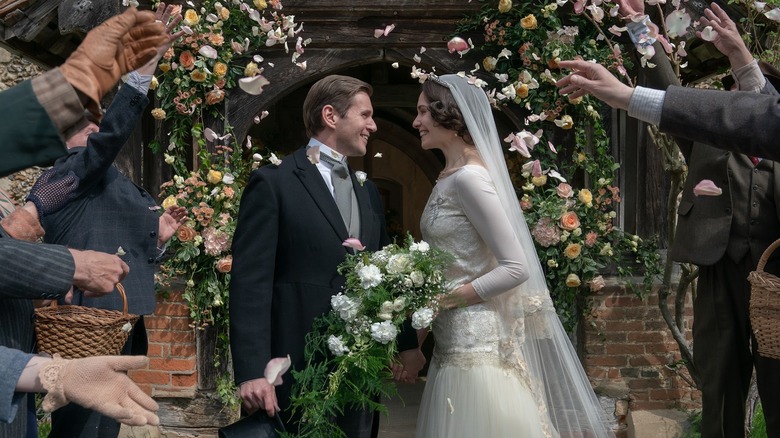
Costume dramas' wardrobe departments allow a peek into a bygone era in which the fashion of the past is made anew, and in "Downton Abbey: A New Era," we get to see the clash of colors, fabrics, and radical clothing as the '30s are just around the corner. Given its place in the early 20th century, "Downton Abbey" allows for the Crawleys to have more of an opportunity to delve into the different fashions through the decades it takes place, while the downstairs staff is often regulated to their uniforms. But in this sequel, Hollywood has come to Downton, which provides nearly everyone with an opportunity to break out of their uniformal clothing constraints and try something new.
With "Downton Abbey: A New Era" now available on Digital, and arriving soon to 4K, Blu-ray, and DVD (July 5), I got to speak with the film's costume designer, Anna Robbins, whose splendid work has been showcased with "Downton Abbey" since the series' fifth season, about the influences of the film within a film, in addition to how it contrasts with the evolving fashion of the aristocratic Crawleys. It was made an even more memorable experience in that our conversation took place within The Church of St. Mary, the same 14th century location where Tom (Allen Leech) and Lucy (Tuppence Middleton) get married at the top of the film.
'I Think Our Idea Very Early On Was That Her Palette Should Be Really Different To The Palette Of The Women Of Downton Abbey'
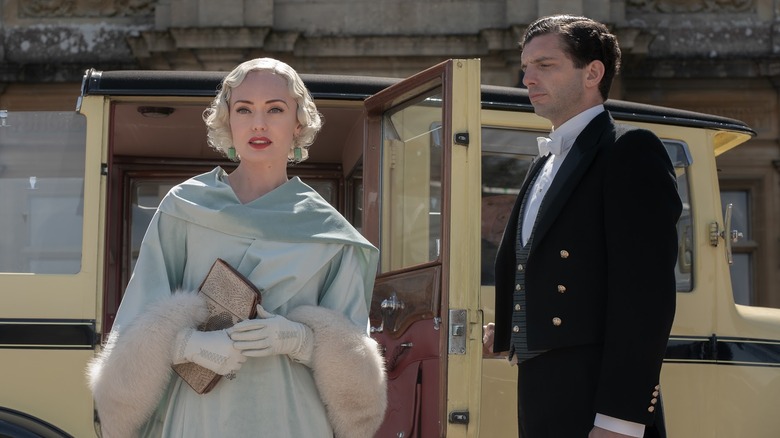
So one thing I really love, one of my favorite scenes in the film, is when the downstairs crew comes up for Mr. Barber's film, and I wanted to ask, did anyone have any special requests for their costumes?
I mean, lots of requests. It was like the kind of big opportunity to dress, how we always imagined it, and it was just so lovely for it to actually come true. I think the first request, it was an unsaid request because Lesley Nicol's been dreaming for years about wearing a tiara. So that was one of the first things I think we sourced for that scene, is that we knew that this was the opportunity that we'd able to pop some diamonds onto Mrs. Patmore. And so, yeah. There was that, I mean, there was the sense of Baxter's costume being as romantic as possible because we knew that there was going to be the proposal and ... it was I think about just finding each character in a completely different way and being able to really showcase them.
I was really struck by Mrs. Hughes, considering we always see her in usually like a black or a dark blue, and she comes down in kind of like this midnight blue outfit that really accentuates her for the film.
Yeah. I mean, and she's still covered up as well, Mrs. Hughes. You don't see much of her. She's always really proper. So the fact that you're seeing skin and it's like these really beautiful necklines and full skirts and she just looked beautiful because there's such a contrast to the Mrs. Hughes that we see day in, day out in one or two costumes first.
Exactly. I think when Myrna has her big movie star entrance, she has an amazing blue coat with the fur that's only there for that one moment, but it's such a powerful moment. How did you come about making everything for that one? It's only in that one scene, but how did you decide on that costume in particular?
It felt like one of the most important costumes for Myrna, and I think our idea very early on was that her palette should be really different to the palette of the women of Downton Abbey. And it was about looking at these icy tones that kind of reflected her slightly standoffish personality, complimenting this platinum blonde that Nosh [Anne Oldham] designed for her wigs and looking at the Hollywood glamor and the kind of the Hollywood actors of that time and drawing inspiration from how glamorous they were.
It's like a very different idea of beauty to the classic beauty of the ladies of the Abbey, so I think that was what we wanted to get was this amazing contrast. And we found these incredible original shoes. And then knowing that we got that lovely pan out shot, where we get to feature them was amazing because often you don't get to see the shoes. And so that was great. I had a great co-designer on the film, Maja [Meschede]. And Maja led on this costume, and so it was her idea to have this really icy blue and the shape of the cape to give this really dramatic silhouette as she stalks into the abbey. And yeah, it's like costume perfection. Yeah.
'It Was About Finding This Lovely Mashup Of 19th Century Silhouettes With '20s Materials, '20s Jewelry, '20s Styling'
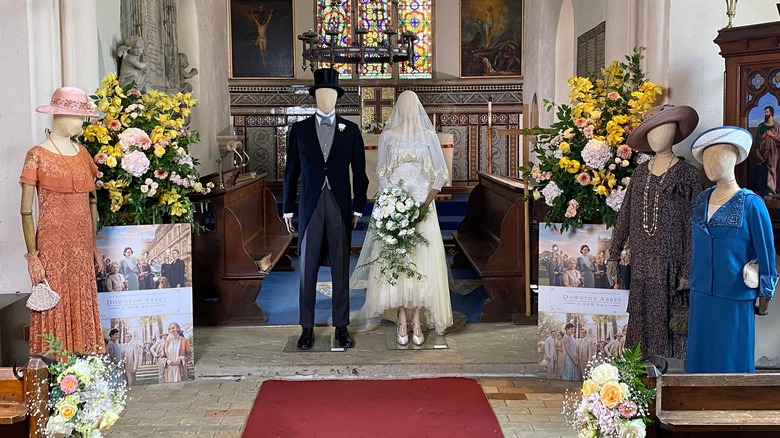
I was really curious about your influences from the silent era to early talkies. Did you have any [films] in particular that you used to kind of mold the cast of Mr. Barber's film?
There were lots of different factors. So we had the crew coming in, and so we had loads of amazing images of film crews from that time. And it was really picking apart and seeing that there was a real sense of separates being worn, which felt really contemporary compared to the three-piece suiting of the aristocratic classes. So there was like a kind of a relaxed, arty vibe to it, looking at the kind of Bloomsbury lot and just trying to get a sense of it feeling like a very different world that was coming in. So there was the crew, but then there was the cast where there was the kind of glamor of Hollywood and looking at the greats from that era, like Clark Gable and Marlene Dietrich and Greta Garbo and Myrna Loy and Louise Brooks. So great people that we could tap into there.
And then there was the other layer, which was the fact we were able to explore the 1870s through a 1920s lens. So we were able to look at films that had been made in the '40s that were set a century before the '60s, even, and looking at what it was that still said, "This is 1964" or whatever. And it was this sort of funny mix of period with what would've been contemporary at the time. So it was about finding this lovely mashup of 19th century silhouettes with '20s materials, '20s jewelry, '20s styling. And so there was just so many layers to the film within the film that, yeah, it was great fun to costume.
And as Downton heads into the '30s, I've noticed a lot more casual wear in "A New Era." Who do you feel had the most radical costumes for the period?
In terms of radical costumes, I would say that Lady Edith takes a massive sartorial jump forward into trousers. The pajama set on the Riviera at that time was all the rage and was, again, some great visual references there. So it felt like the right moment that she would've taken that step. It felt fitting and that she would've been the person to embrace that look. I mean, we have Lucy and Branson in swimwear. That was really fun to do. The tennis wear, as well, was great. That was a really kind of lovely ensemble piece to be able to look at that. I don't know, the list goes on.
It just keeps going. There was one more thing I wanted to ask. You mentioned Phyllis's dress when she has the big proposal scene. And I thought it was great how her floral arrangements with the flowers on top kind of mirrored Myrna in her final scene. Was that an intentional thing to like mirror the proposal that kind of overshadows the actor?
Yeah. I mean, it was always going to be like such a special moment. Molesley makes me cry. Just seeing him, Kevin [Doyle], on camera is just a joy to behold. So I knew that scene was going to be really emotional and it needed to feel really romantic. And so there's these vintage silk flowers on her dress that are part of my personal collection because I collect them when I see them and we just wanted it to feel really special. So if it resonates with Myrna's A-list Hollywood, glamorous looks, then wonderful.
"Downton Abbey: A New Era" is on Digital now and hits 4K/Blu-ray/DVD on July 5, 2022.
Read this next: 20 Underrated Rom Coms You Need To Watch
The post Downton Abbey: A New Era Costume Designer Anna Robbins on Bringing the Allure of Hollywood Glamor to Downton [Interview] appeared first on /Film.
Microsoft Finds 'Raspberry Robin' Worm in Hundreds of Windows Networks
Read more of this story at Slashdot.
Is Apple taking the lazy way out with the MacBook Pro 13?
During Apple’s Worldwide Developer Conference 2022, the company gave us a glimpse of its future, sharing announcements for iOS 16, iPadOS 16, watchOS 9, and macOS 13. Along with software, Apple also showed off new hardware, announcing its new MacBook Air (2022) and more surprisingly, an “updated” MacBook Pro 13. While the former was a breath of fresh air with its all-new design, the latter looked familiar and dated.
Apple took the easy lazy way out with the MacBook Pro 13
To be clear, Apple hardware has been pretty good for the past decade, but there have been some missteps. Under the direction of legendary designer Jony Ive, Apple replaced its keyboard technology for the worse, removed ports from its “Pro” laptops, and even got rid of its beloved MagSafe charging system. It would also introduce new technology with its Touch Bar system, which wouldn’t really catch on as anticipated. It chose to overcomplicate certain parts, but strip down other areas, choosing simplicity over a great user experience. This was a dark era for MacBook users and while Apple stuck to its guns for years, it would eventually right its wrongs by going back to the old formula. Because of this, many would rejoice with the release of the the MacBook Pro 14 and MacBook Pro 16. and Apple would continue moving forward with the release of the MacBook Air (2022).

The 2020 Intel-powered 13-inch MacBook Pro (left) and the 2022 M2-powered 13-inch MacBook Pro (right).
Because of all of this forward momentum, one has to question, after accomplishing so much over the past 18 months, why would Apple go backward? Why would it proudly showcase an older design, complete with Touch Bar, a blatant reminder of a flawed product – an era of Apple that wasn’t as solid. There are a number of reasons why this could have occurred, and we will never really have a solid answer, but Apple could have just kept moving forward. For a company the size of Apple with the immense resources at its disposal, figuring out a different design for the MacBook Pro 13 would have been possible, and even possibly an easy task considering the blueprints available from the redesigned MacBook Air 13 and the MacBook Pro 14.
Alternatively, the company could have chosen to skip the MacBook Pro 13 instead of renewing its life in an outdated format for yet another year. Of course, by not having a MacBook Pro 13, there would be a hole in Apple’s current lineup, but if this is a transitional period, so be it. Apple could have just kept the lineup as is for another year. Although there are previous examples of Apple using an older chassis design for its first M1 SoC laptop, that was a different moment. Apple was debuting a new SoC for the first time and entering uncharted waters. I think in this instance, it was limiting risk by using an old design and maximizing the use of its existing supply chain. But that was then when Apple had an unproven SoC. Now, it’s a clear winner, and mixing and matching parts is just in bad taste. It reeks of profiteering off an established supply chain without really putting in any thought and effort to give consumers more than the bare minimum.

Furthermore, if Apple wanted to keep something “old”, it could have used the MacBook Pro 13 chassis without a Touch Bar. This would have looked a bit more like the current lineup and would have probably cost Apple and consumers less. Because as it stands right now, the MacBook Pro 13 sits in awkwardly between the MacBook Air 13 and the MacBook Pro 14, losing the benefits of being cheaper and powerful respectively from the option at either end.
Regardless, Apple’s MacBook Pro 13 (2022) will arrive very soon to customers and there is no telling how popular it will be. But hopefully, the reactions are tepid and consumers will voice their opinion with their dollars.
Do you think Apple took the easy way out with the MacBook Pro 13 (2022)? What would have been a better execution for this? Did the M1 MacBook Pro 13 really need an M2 upgrade? Let us know in the comments below!
The post Is Apple taking the lazy way out with the MacBook Pro 13? appeared first on XDA.
The Horror Sequel Homage That Almost Made It Into Stranger Things 4
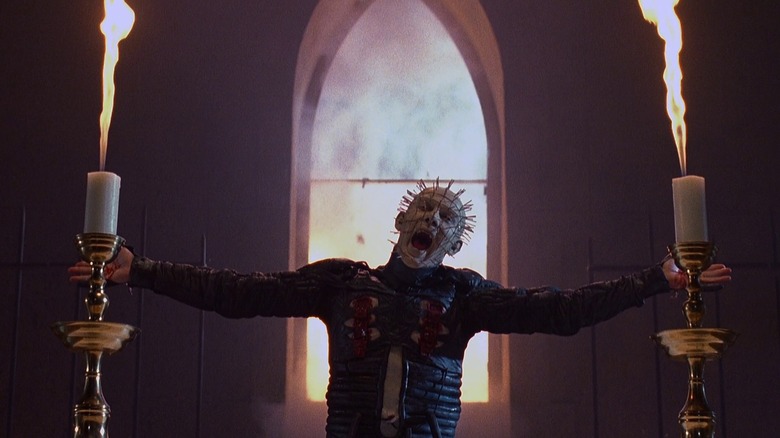
"Stranger Things" is no stranger to a cinematic homage. In its early days, the show felt like a mashup between Steven Spielberg hits like "E.T." and Stephen King classics like "Stand By Me." The newest season draws liberally from horror movies, particularly supernatural '80s slashers like "A Nightmare on Elm Street." In a recent roundtable interview I attended with Jamie Campbell Bower, the actor delved deeper into some of this season's monstrous inspirations, and shared his vision for one scene that ended up on the cutting room floor.
Bower, who plays the Upside Down's head monster Vecna along with his previous human self, Henry, revealed that Clive Barker's "Hellraiser" franchise was a go-to source of inspiration for the character. "Vecna is a huge homage to Pinhead," Bower said, referencing the extra-dimensional entity made famous by Doug Bradley. He also pointed out that the character lives in an attic, just like the cenobite-tortured character Frank does in the original 1987 film.
Bower wanted to dive even further into the "Hellraiser" mythos in season 4, suggesting that the showrunners, the Duffer brothers, pay homage to a scene from 1992's "Hellraiser III: Hell on Earth.":
"There were a lot of homages to great horror movies. And there was one that I tried to get in as well ... I don't know if you've seen the third 'Hellraiser' movie, but there is a scene where Pinhead goes into the church and takes out one pin from his head, another pin from his head, puts them in his hands, stands there like this and says, 'I am the way.' And then the church windows blow in."
A Hellraiser Reference Gone Wrong
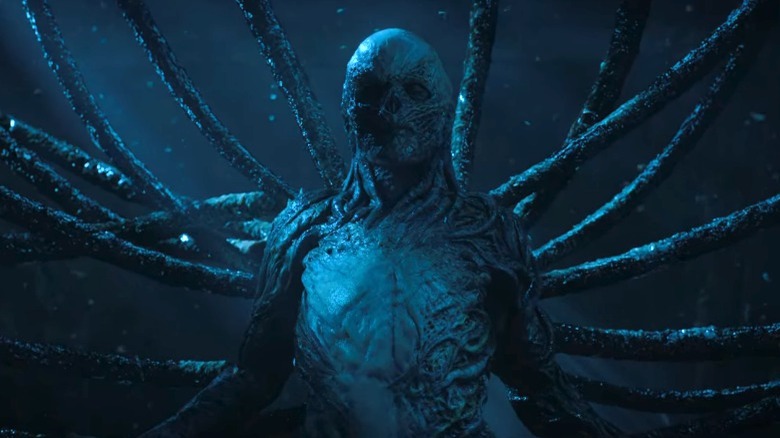
The actor said he proposed that a particular scene in which Vecna is hovering in the attic could be reshot in order to pay respect to the classic Pinhead moment: "I was like, 'That'd be amazing to pay this homage to this incredible character and this wonderful actor, Doug Bradley." He also shared that, during his attempt to talk the Duffers into shooting the scene, he said that Vecna would look "kind of like Jesus," which would be in line with this season's dark spin on religion.
Bower revealed that the Duffers were on board, but that the visual homage didn't come through as well as he'd hoped: "We did it and it looked like absolute crap," he admitted. They didn't end up using the footage. "They had already said to me, 'Just keep your arms [at] both sides. It's going to look great,'" Bower shared, "and I was like, 'No, no, let me try it, let me try it.' We did it. And it was awful."
Well, you can't win them all. As cool as Vecna is, he's not quite the same type of scary as Pinhead. The Upside Down monster is capable of crushing peoples' heads like walnuts, which would probably make a simple arm raise seem a little anticlimactic. Still, the horror icon was a constant presence on the "Stranger Things" season 4 set. Bower also revealed that one of the Duffer brothers would purposely wear "Hellraiser" T-shirts on days when he worked with the actor.
Read this next: Every Main Character In Stranger Things Season 4 Ranked Worst To Best
The post The Horror Sequel Homage That Almost Made it Into Stranger Things 4 appeared first on /Film.
From Star Trek To Thor: Love And Thunder, Let's Trace Chris Hemsworth's Slow Slide Toward Comedy
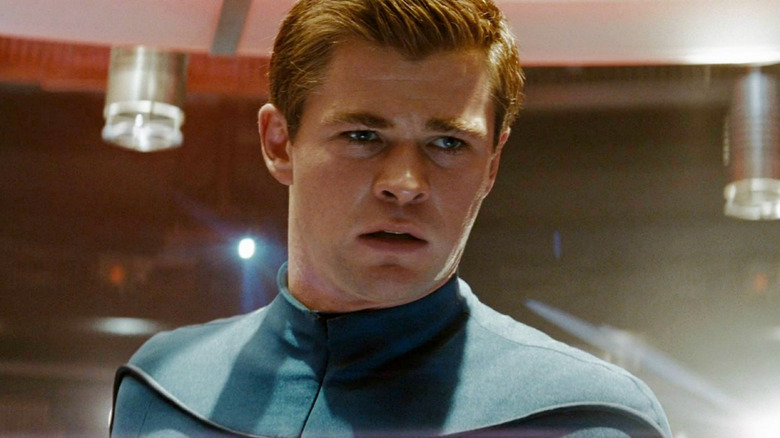
One might think playing Thor in the Marvel Cinematic Universe would make it easier for Chris Hemsworth to have free rein when it comes to his other projects, but that hasn't always been the case. Far too often, the actor has found himself with a gun in his hands and scruff on his face, starring in potboiler fare like "Red Dawn," "12 Strong," and "Extraction." Even the "Snow White and the Huntsman" films mistake Hemsworth's strengths as being that of an action hero first, a good-humored character actor second. Yet, as evident by his role in "Thor: Love and Thunder," the further Hemsworth has slid into comedy, the more he's come into his own as a performer.
Like so many Australian actors turned Hollywood stars, Hemsworth got his start acting in soap operas in his home country. After three years and many, many episodes working on the Aussie soap "Home and Away" from 2004 to 2007, the man who would be Thor landed his big break playing James Kirk's doomed father, George Kirk, in the high-octane prologue to J.J. Abrams' "Star Trek" in 2009. One look at the actor in that movie (in which he appears for less than 10 minutes), and you can see why Marvel executives would be inclined to cast him as the blonde, brawny God of Thunder in the MCU.
What they didn't know, however, is that Hemsworth's comedy muscles and talent for self-deprecation are far more awe-inspiring than any amount of physical bulk he could ever hope to attain.
Hemsworth: The Early Years
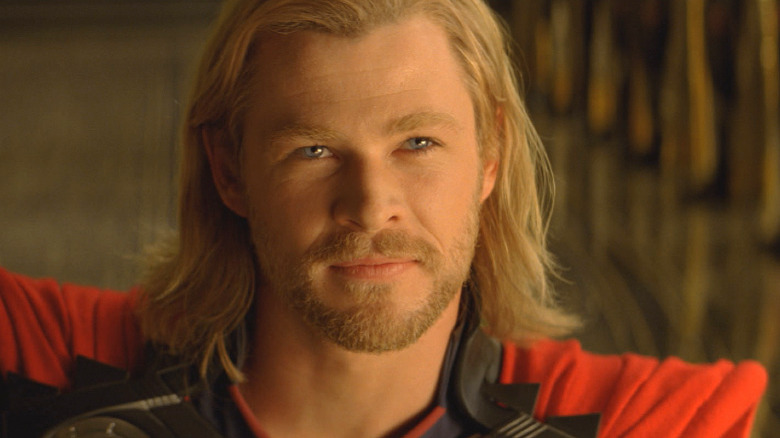
You can see the early signs of Chris Hemsworth's comedic prowess in 2011's "Thor," when the God of Thunder is a fish out of water adjusting to life without his super-powers on Earth. The difference between Kenneth Branagh's film and the actor's later work in the role is that Hemsworth plays the character without a hint of self-awareness, even when he's doing the now-classic Thor window face-plant or striding into a pet store and demanding he be given a horse, no questions asked.
It would take another five years for the Marvel Cinematic Universe to really tap into that potential. Instead, as with the first "Thor" film, much of the humor in 2013's "Thor: The Dark World" and Joss Whedon's "Avengers" movies plays on Thor's ego, along with the comedy inherent to a god-like alien trying to fit in with everyday humans. Likewise, in director Drew Goddard's 2012 meta horror-comedy "The Cabin in the Woods" (which Whedon co-wrote), Hemsworth plays a well-read college jock who mostly serves as a straight man, allowing the comic relief characters to bounce jokes off of him as the story begins to take stranger and stranger turns.
Even when he wasn't working on the MCU (or with Whedon), Hemsworth stayed away from comedies during this period. He instead focused on expanding his range as a dramatic actor by teaming with directors such as Ron Howard ("Rush"), and launched a far less successful second action-fantasy franchise with his role in "Snow White and the Huntsman." Then came 2015's "Vacation" revival, in which Hemsworth played his muscly physique for laughs in his small role as protagonist Rusty Griswold's — to put it politely — well-endowed brother-in-law.
However, it was another 1980s comedy franchise relaunch that really gave Hemsworth the chance to earn his comedy stripes.
From Bustin' Ghosts To Battling Thanos
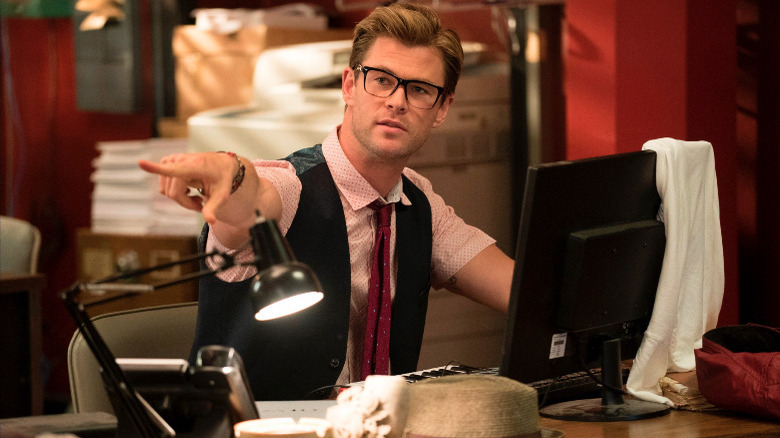
Say what you will about the 2016 "Ghostbusters" (I'm a fan myself), but it was Paul Feig's reboot that prepared Chris Hemsworth for Taika Waititi's irreverent, improv-heavy reinvention of the "Thor" franchise. Unaware that Feig, like Waititi, employs a lot of improvisation in his comedies, Hemsworth signed on for the film without fully knowing what he was getting into. Upon learning the truth, he's admitted to fearing he would ruin both the movie and his career in one fell swoop.
Quite the contrary, Hemsworth managed to go toe-to-toe with the movie's cast of improv experts and comedy veterans, along the way creating one of the greatest himbos in recent film history with the Ghostbusters' (mostly-useless) receptionist, Kevin Beckman. Clearly bolstered by the experience, Hemsworth wholly embraced the task of evolving Thor into a good natured yet bumbling hero, starting with his appearances opposite Daley Pearson as Thor's put-upon flat-mate Darryl in the Waititi-directed "Team Thor" mockumentary shorts in 2016.
By the time Thor returned to the big screen in 2017 with Waititi's "Thor: Ragnarok," he had completed his evolution from self-serious God to lovable, blonde-haired, wise-cracking clown in the vein of Kurt Russell's Jack Burton from "Big Trouble in Little China." Like all of Waititi's work, though, "Ragnarok" blends zany humor with pathos as it strips Thor of everything that had defined him in the MCU up until that point. This would then pave the way to his arc in "Avengers: Infinity War" and "Avengers: Endgame," including the latter's problematic depiction of Thor's struggles after failing to prevent Thanos' snap.
To his credit, though, you get the sense Hemsworth is sympathetic to Thor's plight in "Endgame," even when the film is not. In this case, the actor's tragicomical intuitions proved to be a saving grace.
Feel The Love (And Thunder)
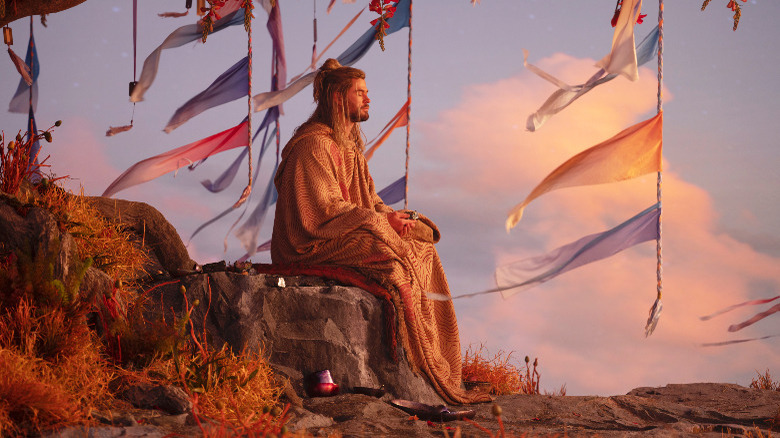
Jump to the present, and moviegoers have grown fully accustomed to Chris Hemsworth being a comedic actor first, even when he isn't playing Thor. And while the results haven't always been great, they have paved the way to the actor taking on roles he might have avoided in the past, like the beguiling sociopaths he portrays in the films "Bad Times at the El Royale" and "Spiderhead." In both cases, Hemsworth uses his well-honed image as a riotous good guy against the audience, luring them in just as the villains he's playing seduce their victims with their deceptive charms and untrustworthy smile.
After voicing an extra silly, hedonistic, alternate reality version of Thor on the animated series "What If...?" (a character fittingly dubbed "Party Thor"), "Thor: Love and Thunder" gives Hemsworth a chance to further marry his dramatic skills with his comedic sensibilities. Taika Waititi's film finds the God in the midst of an existential crisis, eager to leave his superhero days behind him but unable to do so when troubles comes a-knocking at his door once more. In that regard, it serves as the perfect culmination of Hemsworth's slow but steady slide into comedic territory over the past decade.
"Thor: Love and Thunder" opens in theaters on July 8, 2022.
Read this next: The 10 Best Comedies Of The Last 10 Years
The post From Star Trek to Thor: Love and Thunder, Let's Trace Chris Hemsworth's Slow Slide Toward Comedy appeared first on /Film.
Silent Hill 2 Enhanced Edition 2.0 Gets Installer, Launcher, and Audio Fix

Silent Hill 2 Enhanced Edition was recently updated to version 2.0, which introduces a number of important features to the enhancement project.
For example, there is now an installer program that makes the installation process much easier. Similarly, Silent Hill 2 Enhanced Edition can now be fully configured before launching the game through a handy launcher tool.
Then there's the highly anticipated audio fix for the skipping sound that affected all modern PCs with multicore CPUs. Silent Hill 2 Enhanced Edition now features a custom streaming audio engine that resolves this and also fixes the stutter in cutscenes dialogues. Additionally, the FMV enhancement pack has been further improved by taking advantage of the latest in AI upscaling technology.
You can read the full changelog below, or watch the video recap right after the update notes.
What's New in Silent Hill 2 Enhanced Edition version 2.0?
- Added a configuration tool and launcher (SH2EEconfig.exe) to the project
- Added a new CriWare audio sound engine for the game
- Added multithreading support
- Added a new option
FullscreenVideosdetect and auto set the correct video placement, to replaceFMVWidescreenMode- Added ability to fix end.bik and ending.bik mismatch
- Added an option to fix the game crash that occurred when loading Game Result
- Added ability to Limit noise filter vertex to FMV coordinates
- Added an option to fix in game Advanced Options menu text
- Added an option to fix the pause menu "Save Game" button sound effect
- Added the ability to drop 'd3d8.ini' and 'd3d8.res' if they don't exist
- Added a fix for the pause menu when "Resume Game"
- Added an option to enable Alternate Stomp
- Added an option to position James inside closet after cutscene
- Added an option to fix the final boss's moth attack and chainsaw sound looping issue
- Added the ability to display 'free space' in KB, MB, GB and TB
- Added a fix for the 1 pixel gap in cutscene letterboxes
- Added a fix for the crash in quick save After Meeting Maria
- Added an option to specify wrapper type
- Added an option to fix fade out bug remnant from Xbox
- Added the ability to allow custom resolution with ResX and ResY
- Added a fix for the Inventory BGM
- Added a fix for the BGM issue on loading
- Added entries to log all loaded modules
- Added the ability to always launch game window on top of all other windows
- Added detection if GDI will work for getting front buffer data
- Updated the mod updater feature to work with the SH2EEsetup tool
- Updated resolution to be stored in a local file rather than the registry
- Updated the script dll to load first
- Updated the audio clip prevention to not using threading
- Updated Anisotropic Filtering to be disabled by default
- Updated BeginScene/EndScene pair only once per frame, as documented by Microsoft
- Updated default window background to black
- Renamed the
SingleCoreAffinitytoSingleCoreAffinityLegacy- Fixed some issues with delayed start
- Fixed surface lock emulation when using AntiAliasing
- Fixed issue with reading texture and video resolution
- Fixed an issue with the hooking used for the custom mod folder feature
- Fixed Windows XP compatibility
The post Silent Hill 2 Enhanced Edition 2.0 Gets Installer, Launcher, and Audio Fix by Alessio Palumbo appeared first on Wccftech.
NVIDIA & AMD GPU Prices Saw 57% Drop Since The Beginning of 2022, 14% Used GPU Price Drop Since June Alone

Over the several months, GPU prices, especially NVIDIA and AMD's latest generation graphics cards, have normalized in price, allowing more accessibility for new and current users to purchase the graphics card they need affordably. However, the market is gradually filling up with used GPUs from users and the crypto mining community's fair share of used GPUs in mining rigs. This overabundance of options in the used and retail marketplaces creates difficulty for consumers looking for an affordable option in used technology, unsure of the lifespan of the used GPUs.
Prices for NVIDIA & AMD GPUs dropped another 14% last month, over 57% since January
Tom's Hardware has closely followed the price decline over the last several months and noticed that last month, prices dramatically fell for AMD & NVIDIA GPUs in the used marketplace, from sites like eBay. Last month, the used market witnessed a fourteen percent decline, with seventeen percent falling on the latest generation graphics cards, like NVIDIA's RTX 30 series and AMD's RX 6000 series. The retail markets have seen a less dramatic decline, only a three percent drop from the previous month.
Currently, a user can go into the used marketplace for a graphics card and see a plethora of options, from gamers who purchased their GPUs at excessive amounts during the shortage to crypto miners trying to reclaim their return on investment from the rigs created.
Tom's Hardware tabulated a list of NVIDIA's low-performing to mid-performance graphics cards and the AMD identical cards to show the change in pricing in both retail and used marketplaces. Readers should note that a majority of these cards were released during the shortage, and the prices were already higher than the estimated manufacturer's retail pricing.
| Graphics Cards — 2022 Price Change | |||||||
|---|---|---|---|---|---|---|---|
| Tom’s Hardware | eBay Price on July 1 | eBay Price on Jan 1 | Retail Price on July 1 | GPU MSRP | eBay YTD Change | Retail vs eBay Price | Retail vs MSRP |
| NVIDIA GeForce RTX 30 Graphics Cards | |||||||
| GeForce RTX 3090 Ti | $1,387 | — | $1,670 | $2,000 | — | 20% | -17% |
| GeForce RTX 3090 | $1,043 | $2,918 | $1,459 | $1,500 | -64% | 40% | -3% |
| GeForce RTX 3080 Ti | $921 | $1,992 | $1,075 | $1,200 | -54% | 17% | -10% |
| GeForce RTX 3080 12GB | $812 | — | $800 | N/A ($800?) | — | -1% | 0% |
| GeForce RTX 3080 | $707 | $1,783 | $800 | $700 | -60% | 13% | 14% |
| GeForce RTX 3070 Ti | $587 | $1,244 | $698 | $600 | -53% | 19% | 16% |
| GeForce RTX 3070 | $495 | $1,179 | $580 | $500 | -58% | 17% | 16% |
| GeForce RTX 3060 Ti | $433 | $1,007 | $470 | $400 | -57% | 9% | 18% |
| GeForce RTX 3060 | $365 | $761 | $390 | $330 | -52% | 7% | 18% |
| GeForce RTX 3050 | $299 | — | $328 | $250 | — | 10% | 31% |
| AMD Radeon RX 6000 Graphics Cards | |||||||
| Radeon RX 6950 XT | $1,125 | — | $1,060 | $1,100 | — | -6% | -4% |
| Radeon RX 6900 XT | $703 | $1,527 | $850 | $1,000 | -54% | 21% | -15% |
| Radeon RX 6800 XT | $637 | $1,387 | $690 | $650 | -54% | 8% | 6% |
| Radeon RX 6800 | $529 | $1,282 | $600 | $580 | -59% | 13% | 3% |
| Radeon RX 6750 XT | $526 | — | $540 | $550 | — | 3% | -2% |
| Radeon RX 6700 XT | $391 | $898 | $450 | $480 | -56% | 15% | -6% |
| Radeon RX 6650 XT | $360 | — | $380 | $400 | — | 6% | -5% |
| Radeon RX 6600 XT | $273 | $659 | $360 | $380 | -59% | 32% | -5% |
| Radeon RX 6600 | $252 | $578 | $275 | $330 | -56% | 9% | -17% |
| Radeon RX 6500 XT | $175 | — | $186 | $200 | — | 6% | -7% |
| Radeon RX 6400 | $150 | — | $160 | $160 | — | 7% | 0% |
The website notes, "Total card sales for both previous- and current-generation GPU were down compared to May, which isn't surprising, as the lower prices mean there's less enticement for people to try to offload older hardware."
Another interesting note from the article is looking at the Ethereum network hash rate during that time. The hash rate rose from 228.2 TH/s to 1126.7 TH/s between September 2020 to May 2022. The total increase is around 898.5 TH/s, which, when considering the amount of graphics cards used to mine that number, is quite frankly, astronomical.
The post NVIDIA & AMD GPU Prices Saw 57% Drop Since The Beginning of 2022, 14% Used GPU Price Drop Since June Alone by Jason R. Wilson appeared first on Wccftech.
Rebel FM Episode 545 - 07/01/2022
How Drunken Master Completely Changed Jackie Chan's Career
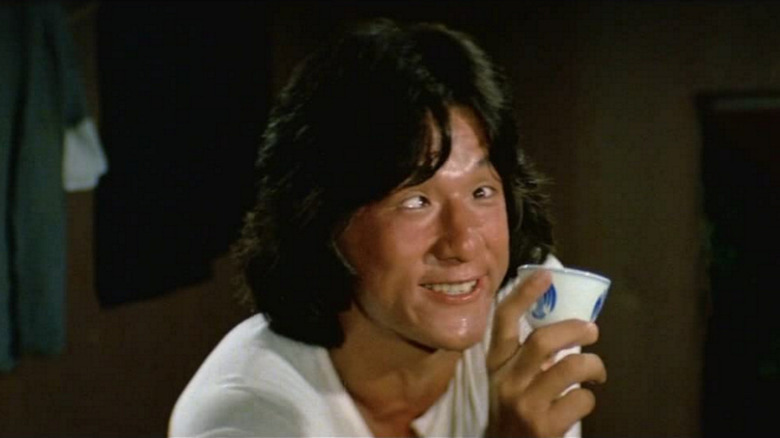
1978 was a great year for kung fu films. First came "The 36th Chamber of Shaolin," featuring the greatest and most detailed martial arts training sequence in cinema to date. Then came "The Seven Deadly Venoms," the beginning of a popular series directed by master of sadomasochistic revenge thrillers Chang Cheh. And then there was "Drunken Master." Released in October of that year, the film was neither an earnest tale of self-improvement like "36th Chamber," nor a rock-beats-scissors festival of violence like "Seven Deadly Venoms." It was a comedy, reinterpreting the Cantonese folk hero Wong Fei-hung as a young lout who learns to harness alcohol as a weapon.
"Drunken Master" was directed by a young Yuen Woo-ping, years before he truly made it as a solo director and action choreographer. But it also marks the breakthrough of Jackie Chan, a former Bruce Lee stunt double who would become an icon in Hong Kong and abroad. "Drunken Master" was not the first collaboration between the two, and it wasn't even the first attempt to reinvent Wong Fei-hung for a new generation. But without "Drunken Master," there would be no "Police Story." While Chan would continue to grow as a performer, he became the star he is today in this film.
A Different Style To Bruce
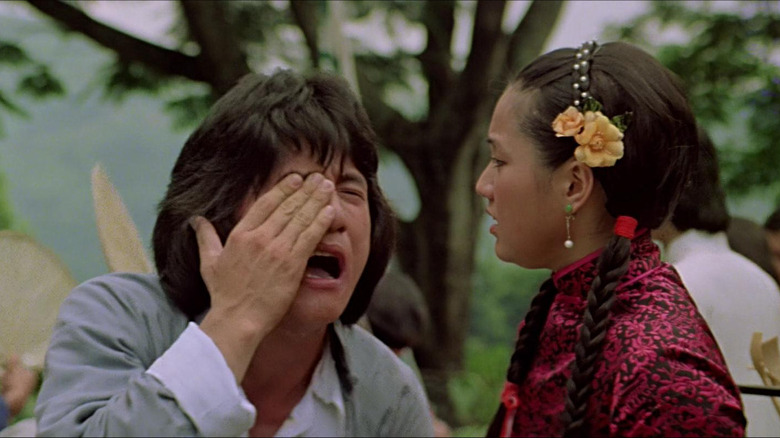
When Jackie Chan entered the film industry, Bruce Lee was the biggest star in the game. Chan served as one of Lee's many stunt doubles, but he also fought for his own part, finally scoring a small role in "Enter the Dragon." After Lee's passing, Chan was scouted as a successor by director Lo Wei. Lo is credited for discovering both stars, but his long career only served to calcify his creative instincts. As far as he was concerned, Chan had no right to buck convention. He was just a young actor, and young actors in the industry did as they were told. Chan was frustrated by Lo's conservatism. In an interview with the South China Morning Post, he said:
"I had a different style to Bruce, my own style, so that wasn't working, and I was looking to make a change."
Chan was finally given the chance when Lo Wei loaned him to the production company Seasonal Films. There he had the opportunity to work with an up-and-coming young director, Yuen Woo-ping. Unlike Lo Wei, Yuen had no preconceptions as to what kind of star Chan should be, or even what movie they should make together. When Chan suggested a comedy, Yuen decided to go with it, and he roped in his father, Yuen Siu-tien, to serve as Chan's mentor figure. The final result, Yuen's directorial debut, was "Snake in the Eagle's Shadow." Hong Kong audiences enjoyed the comedy, the martial arts, and Chan's student-teacher relationship with Siu-tien in the film. So for their follow-up, Yuen and Chan decided to give their fans even more of what they wanted.
An Unchanging Avatar Of Confucian Virtue
While "Drunken Master" was positioned as a spiritual sequel to "Snake in the Eagle's Shadow," it is in fact a movie about Cantonese folk hero Wong Fei-hung. Wong was born in 1847 and was taught the hung gar martial arts style by his father. His escapades, both real and fictional, are serialized in over a hundred movies since 1949. Kwan Tak-hing played the title character in 81 of the films as an "unchanging avatar of Confucian virtue, a reliable patriarch in a tumultuous world," per Grady Hendrix for Criterion. The films also played a role in the gradual shift from chivalric wuxia films to more grounded kung fu movies, courtesy of director and steward Wu Pang. Over the decades, the character of Wong grew stale. Audiences wanted something more complicated than the old-fashioned hero of earlier films. Seeing an opportunity, the Hong Kong film industry strove to deliver.
A 1976 TV production of "Wong Fei-hung" tackled thornier topics like government corruption and international intrigue, even as it brought back a 70-year-old Kwan to play the lead. Meanwhile, director Lau Kar-leung, who would go on to direct "The 36th Chamber of Shaolin," brought audiences "Challenge of the Masters." "Challenge" presents a young and brash Wong, whose father refuses to teach him martial arts. When he is embarrassed in a match, Wong undergoes grueling training at the hands of a strict master to become worthy of his family's legacy. Two years later, Chan and Yuen would steal this formula for their own purposes. But while "Challenge" would take Wong's crisis of faith seriously, Chan and Yuen would transform his story into a farce.
The Eight Drunken Immortals
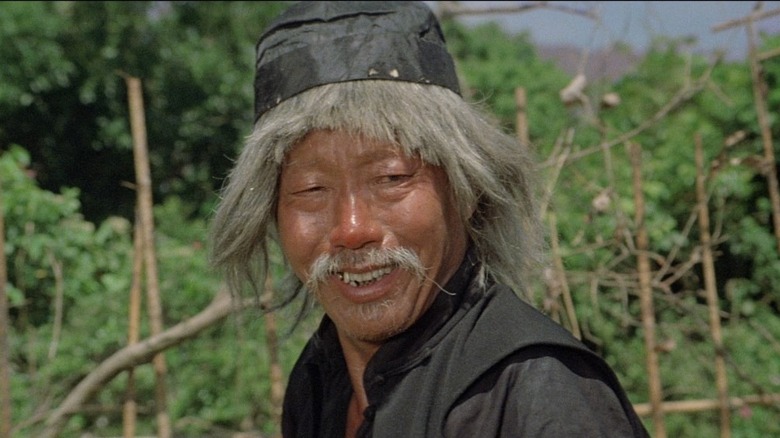
"Drunken Master" asks the question, "What if Wong Fei-hung were a dudebro prankster who uses his martial arts skills to avoid responsibility and pick up women?" From the very beginning, Jackie Chan makes choices that reverse Kwan's take on the character. Rather than respect his elders, Chan pokes fun at them. Rather than training hard, he finds new and hilarious ways to escape. It isn't until he is defeated by the ruthless mercenary Thunderleg that he finally starts listening to Beggar So, the film's mentor figure, played by a returning Yuen Siu-tien. Even then, Wong's greatest humiliation comes when Thunderleg makes him walk between his legs and then steals his pants. This is not a movie about Confucian morals; this is a movie about potty humor.
Chan plays Wong as a jerk, but he finds ways to stay on the audience's good side. First, Wong's disgraceful actions are meant to lampoon earlier, strait-laced portrayals of the character. It's not dissimilar to Graham Chapman's portrayal of the legendary King Arthur as a bewildered, exasperated Englishman in "Monty Python and the Holy Grail." Second, Jackie Chan is just as often embarrassed by others throughout the film as he is to embarrass others. When he creeps on a young woman early in the film, the woman's guardian (and his aunt) obliterates him with a flurry of kicks. Later, when he picks a fight in a restaurant out of bravado, he finds himself beaten and outnumbered by the staff. It is only through the help of Beggar So that he escapes. So teaches Wong "drunken martial arts," a purposefully silly style designed so the opponent underestimates the user's power and control.
Jackie Chan Always Starts Beneath His Opponents
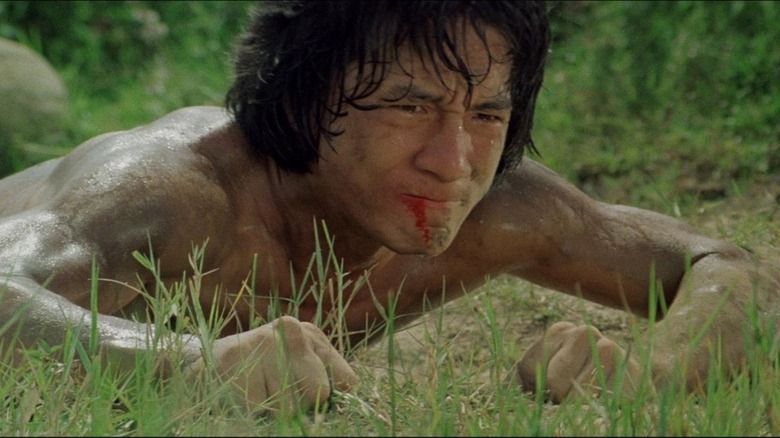
Over the years, the principles became central to Jackie Chan's modus operandi as a performer. "Every Frame a Painting" defines two such principles in the video "Jackie Chan — How to Do Action Comedy." First, Chan always starts as an underdog to his opponents. Chan's Wong Fei-hung is skilled at the beginning of "Drunken Master," but not yet truly great. It takes until the end of the movie for him to challenge the villain Thunderleg on equal terms, and even then, it is a close fight. Over the course of his career, Chan learned he could never take the audience's trust and sympathy for granted. In "Drunken Master," he works hard to ensure the audience is on his side before he proves himself an action hero in the climax.
Second, Chan is not only unafraid to appear vulnerable, he gets hurt. Wong is beaten over and over again in "Drunken Master." Sometimes this manifests as physical injury: a slapped face, a bitten hand. Just as often, Wong is subjected to fear and embarrassment. When he discovers the female master who beat him up resting at his father's house, he tries to sneak away without acknowledging her. His father calls him over to say hello, and Wong ties himself into pretzels to avoid admitting his guilt. Despite everything, his aunt tells his father what happened, and Wong is disgraced. Not to mention that Wong's "Drunken Master" fighting style requires imbibing concentrated alcohol, putting him into a state where he is even more likely to make stupid decisions and injure himself.
The Unbeatable Drunken Master
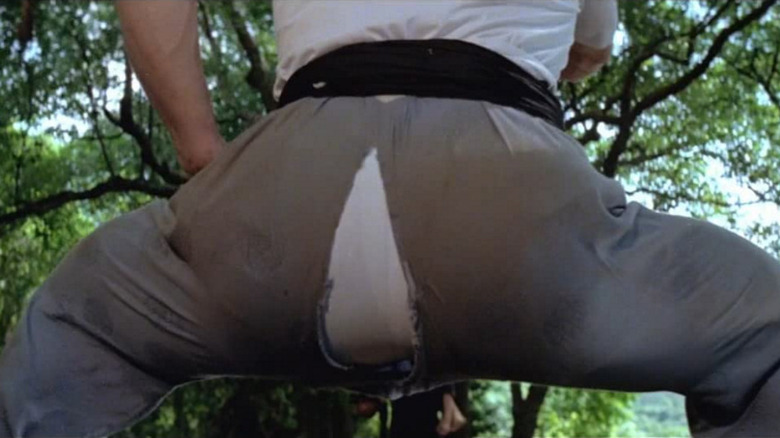
For many modern action stars, a willingness to embarrass oneself to entertain the audience as Jackie Chan does is simply not feasible. According to GQ, actors like Dwayne Johnson and Jason Statham have clauses in their contracts for the "Fast & Furious" films stipulating exactly how much abuse their characters were allowed to take in the fiction. Other actors who began as comedy stars, like Chris Pratt of "Parks and Recreation," later abandoned comedy affectations in projects like "The Tomorrow War" and "Jurassic World: Dominion." Tom Cruise is a fascinating case. His early films position him as a superman, but starting with "Edge of Tomorrow," he's made enduring physical punishment a key part of his screen presence. His work in "Mission: Impossible - Fallout" is even better because of how the audience sees him visibly push his limits.
Chan's genius came about by understanding that there need be no separation between modes. He could take punishment and make it funny, then dole it out and make it exciting. Chan and his collaborators were not the first to realize a martial arts film could be hilarious. They were not the first to play with the story of Wong Fei-hung. They simply made "Drunken Master" in the right place, at the right time, to grab an audience who already liked "Snake in Eagle's Shadow" and wanted a bigger and better film. Seen in the light of later Chan masterpieces like "Supercop," "Drunken Master" may seem quaint. Some even argue that its sequel, "Drunken Master II," is superior. But it is clear to anybody watching the opening sequence of this film, as Wong plays keep-away with his teacher's hat, that while we will never have another Bruce Lee, we should forever be grateful for early Jackie Chan.
Read this next: Jackie Chan's 15 Greatest Fight Scenes Ranked
The post How Drunken Master Completely Changed Jackie Chan's Career appeared first on /Film.
Silent Hill 2 Enhanced Edition Update #8 available for download
The team behind the amazing Enhanced Edition project for Silent Hill 2 has released a brand new update for it. This update introduces a Setup Tool (Installer) and a Configuration Tool (Launcher). In case you weren’t aware, Silent Hill 2: Enhanced Edition is a collection of mods that enhances the game and makes it playable … Continue reading Silent Hill 2 Enhanced Edition Update #8 available for download →
The post Silent Hill 2 Enhanced Edition Update #8 available for download appeared first on DSOGaming.
The Classic Stephen King Novel That Plays A Role In Stranger Things Season 4
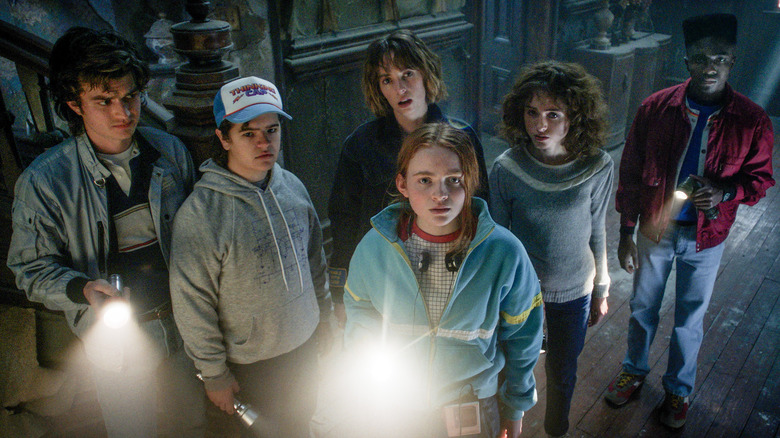
Stephen King has been deeply ingrained in "Stranger Things" from the very beginning. Actually, strike that. King has been a part of "Stranger Things" even before "Stranger Things" was "Stranger Things."
Bear with me, this will make sense in a second.
"Stranger Things" was conceived directly in response to Matt and Ross Duffer getting shut out of a chance at making a movie based on Stephen King's "It." This was before The Duffer Brothers were a powerhouse, and Warner Bros said, "Thanks but no thanks" when they expressed interest in launching an "It" movie. Instead of admitting defeat, The Duffers created a series, then called "Montauk," that would eventually become "Stranger Things" and take over the world. That might have been for the best because we, the constant viewer, got both Andy Muschietti's take on "It" and "Stranger Things," as well.
The kid group in "Stranger Things" mirrors The Losers Club from "It" and even shares a common cast member in Finn Wolfhard. Also, that first season is all about a creepy, humanoid, monstrous figure that steals and eats children and it's up to these kids who really know what's going on to stop it.
The "Stranger Things" font is ITC Benguiat, made famous as the font on King covers like "Cujo," "Misery," and "Pet Sematary," and there's a whole lot of Charlie McGee from "Firestarter" in Eleven. Both are psychically powerful young women born to parents who were tested on by a shady government agency and hunted by that very same agency.
Point is, King and "Stranger Things" go hand in hand, so it should be no surprise when the season 4 finale had a major character actually reading a passage from a Stephen King book, but there's a lot to unpack with the novelistic cameo.
A Meta Nod To A Future Duffer Brothers Project
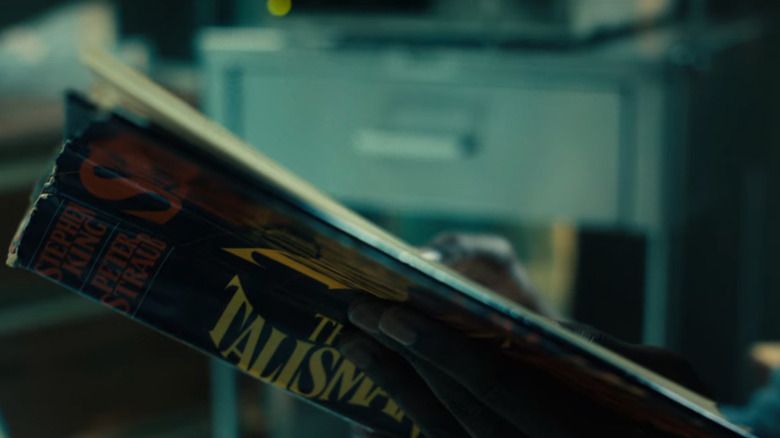
Caleb McLaughlin's Lucas has a hardcover of King's and Peter Straub's young adult fantasy collaboration "The Talisman" cracked at Max's bedside and is reading the story to her. She's in a coma and there's no guarantee she can hear him, but he must know this is something she'd care about. "The Talisman" is about a young boy named Jack Sawyer who goes on a cross-country quest to save his dying mother. Travelin' Jack has the ability to "flip" between our reality and a darker parallel reality called "The Territories." Sounds a little bit like the Upside Down, doesn't it?
"The Talisman" is the rare '80s Stephen King book that has not been adapted. This is the era where everything with King's name was getting put on the big or small screen. Novels ("The Dead Zone," etc), novellas ("Stand By Me"/"The Body"), short stories ("Children of the Corn"), and even a weird mini-novel that started life as an illustrated calendar ("Cycle of the Werewolf"/"Silver Bullet") were all being adapted, so why not this hugely cinematic Amblin-esque adventure tale?
That's a long story, but the short version is that King and his co-writer, Peter Straub, sold the full rights to "The Talisman" to none other than Steven Spielberg. Spielberg spent years trying to crack this giant tome, enlisting screenwriters like Richard LaGravenese ("The Fisher King"), Ehren Kruger ("The Ring"), and Josh Boone ("The Stand") to try their hand at it, but nothing stuck and the movie never happened.
The Territories And The Upside Down
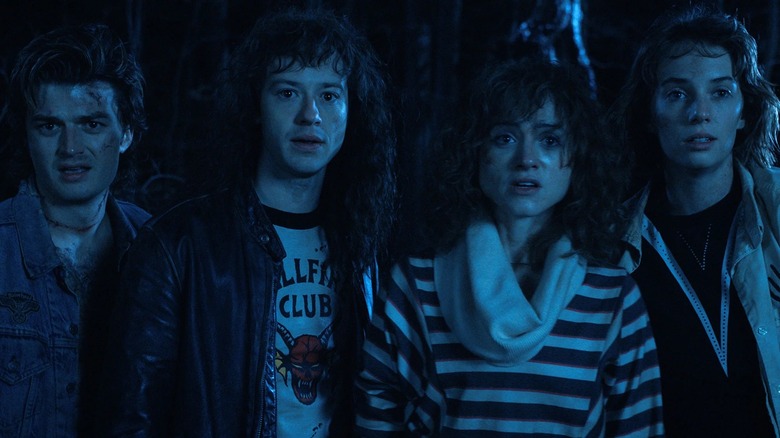
Finally, after almost 40 years, it looks like "The Talisman" is on track to finally be adapted by, you guessed it, The Duffer Brothers. They've teamed up with Netflix and Spielberg to finally make "The Talisman" a reality, or at least they did before Netflix had its recent financial troubles. At any rate, with this talent at the helm and the crazy success of Netflix's tentpole show, it's a safe bet that "The Talisman" is still on and The Duffers will tackle it after "Stranger Things."
So, Lucas reading "The Talisman" is not only a nod to a highly influential King title but also one that we will be seeing sooner than later from the creative team behind the show.
It's also worth pointing out that the particular part of the book Lucas is reading is no accident. This passage is from the young hero, Jack, flips over to that book's version of the Upside Down for the first time. "Speedy! I'm here. My God, I'm here in The Territories." This is Jack calling out to his mentor, a wise older man named Speedy Parker, that he made it into this darker, magic-ruled realm that looks a whole lot like their own.
The Two Steves
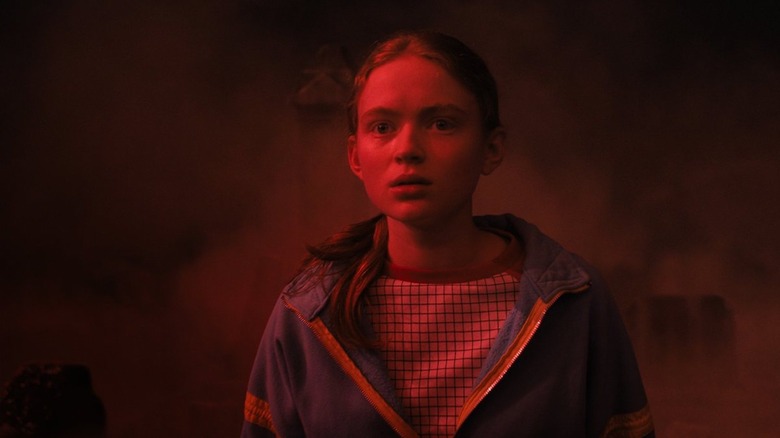
Is this The Duffer Brothers acknowledging on Main that there are similarities between these two titles? Is it just a fun parallel to the tense last few episodes that centered on not just Eleven, but the whole Hawkins gang having to flip into the Upside Down to save the day on their own epic quest?
I had the good fortune to interview The Duffer Brothers a year or so ago for Backstory Magazine and most of that chat focused on the "Two Steves" that raised them, pop-culturally speaking. That is, of course, Spielberg and King. There's just as much "E.T." in "Stranger Things" as "Firestarter." So The Duffers tackling "The Talisman" is about as perfect a fit for that story as there can possibly be.
The only question is when they finally get to it, will they have homaged "The Talisman" so thoroughly in "Stranger Things" that the original inspiration will feel like a retread? It's happened before, and "John Carter" is a prime example. The Barsoom books by Edgar Rice Burroughs served as inspiration for "Star Wars" and a dozen other sci-fi fantasy adventures that by the time it got its day in the sun audiences turned their noses up at it. Been there, done that.
What Is It With Sadie Sink And Stephen King, By The Way?
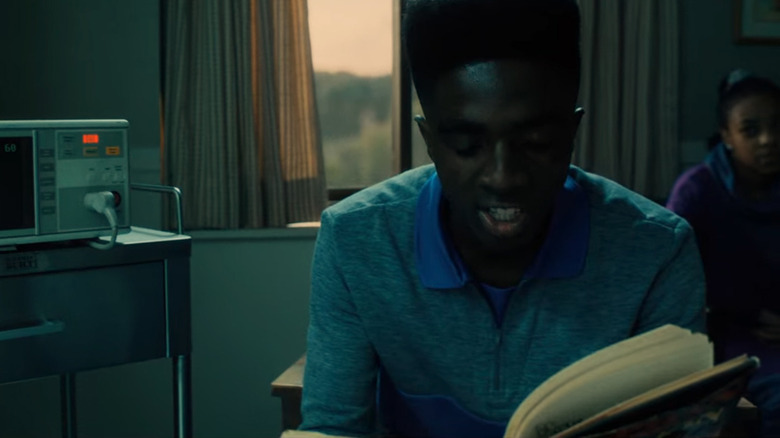
It feels to me like the blatant, focused inclusion of "The Talisman" in "Stranger Things" is The Duffers planting a flag, signaling to their massive audience that both stories can co-exist. Maybe I'm reading too much into it and there's nothing deeper there, but if season 4 has taught us anything it's that this creative team loves to thread small details that have big payoffs down the line.
Or maybe it's all just a rider in Sadie Sink's Netflix contracts that Stephen King books have to be important to her characters. If you remember, an important detail in her "Fear Street" installment was that "Carrie" and "'Salem's Lot" were described to her in great detail.
Whatever the true answer is, this is one Stephen King fan who knowingly nodded his approval at the screen when good guy Lucas had his already battered hardcover copy of "The Talisman" out and was reading it to poor Max, who has been through hell this season. There's nothing that says "I love you" more than reading a Stephen King story. In this house, at least.
Read this next: Where You've Seen Every New Cast Member In Stranger Things Season 4
The post The Classic Stephen King Novel That Plays a Role in Stranger Things Season 4 appeared first on /Film.
Blood: Fresh Supply Collector's Edition
Movies Where The Title Card Appears Surprisingly Late
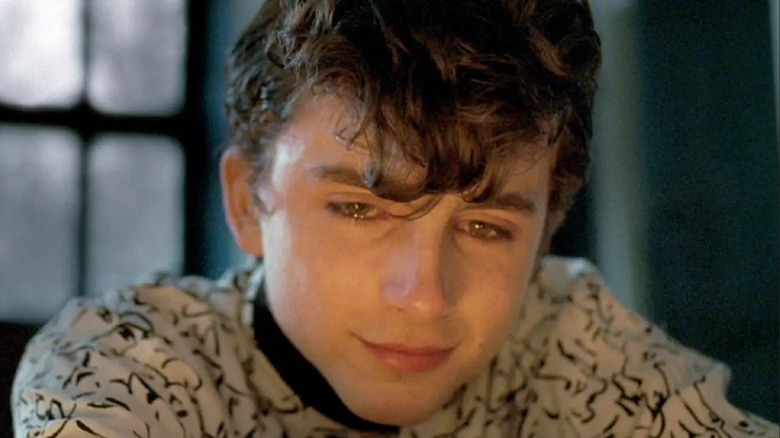
You're sitting in a dark theater in that exciting moment between trailers and the movie you're about to see. The typical experience goes something like this ... it's pitch black, no sound. After a few beats, something appears on the screen. It may be an epigraph, an action-packed cold open, or a beautiful landscape (the opening of a film is always an adventure). Then ... the title card, an often stylized representation of the film's own title that's sometimes followed by a full title sequence.
Title cards have their origins in silent film, originally developed for use as intertitles (title cards in the film itself). By 1903, the time of the classic silent film "The Great Train Robbery," placing title cards towards the front of the film (with the film's title and often copyright info) became fairly common.
But as the decades rolled on and the medium of film evolved, a number of directors have taken that customary intro title card and done surprising things with it -- placing it at specific later moments in a film to punctuate important moments, or shifting it entirely to the end as an exclamation point following a cinematic ride. Here are some of our favorite movies with title cards placed far later than expected.
Raising Arizona
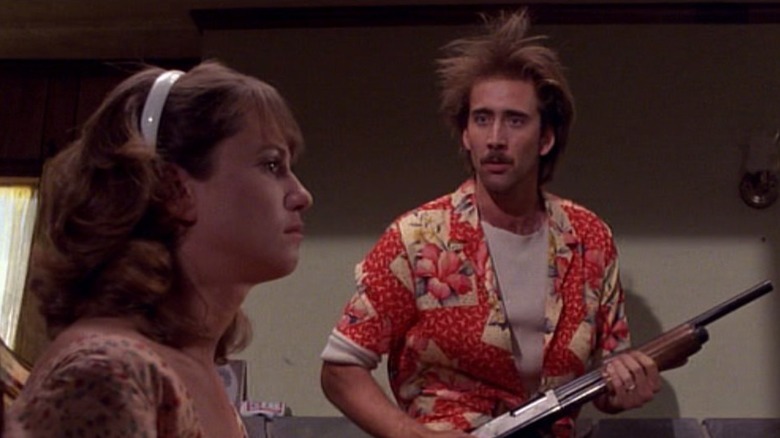
The Coen brothers are widely known for directing original, tightly written films that often cross between a variety of genres: comedy, romance, thriller, you name it. 1987's "Raising Arizona" follows perennial prisoner H.I. McDunnough (Nicolas Cage) and his guard Edwina "Ed" McDunnough (Holly Hunter), an unlikely duo who meet where you'd expect: with the former in jail and the latter his guard. Over time, the two fall in love and eventually get married as McDunnough leaves his criminal past behind ... sort of. The couple desires a child, yet can't conceive. What to do? Like many Coen brothers films, the answer amounts to 'a goofy, half-baked crime.'After a tearful consideration of their own reproductive misfortune and the excessive fortune of others, the duo decide on the most rational course forward: they steal a baby from the wealthy quintuplets of furniture magnate Nathan Arizona Jr. (Trey Wilson) in the hopes of raising it as their own. Police, fellow criminals, and relationship tests abound. The title card drops around the 11 minute mark, immediately following the film's breezy beginning (and complete with whimsical music). The use of the title card here is a signpost: the couple's adventure is starting, warts and all. It follows an emphatically energetic set up, and punctuates it with an equally energetic transition into the meat of the film's arc, catapulting the audience forward in the story.
Mission Impossible: Fallout
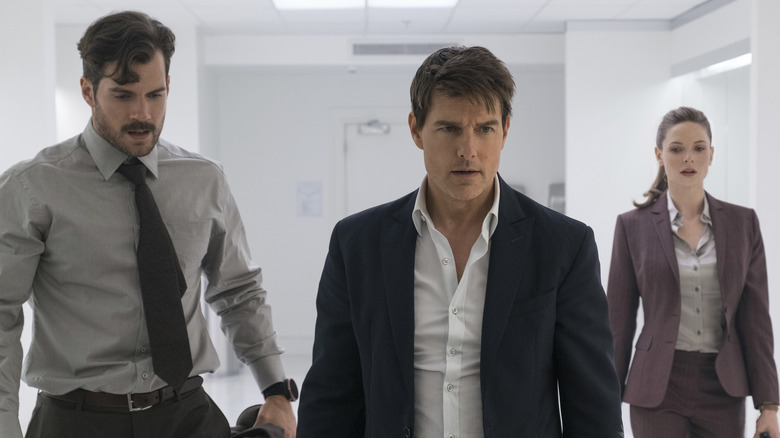
IMF agent Ethan Hunt and his band of fellow agents have dealt with betrayal, been scapegoated for heinous crimes, fought rogue intelligence agencies, and prevented the spread of a terrible pathogen. In "Mission: Impossible -- Fallout," the team has yet another difficult job to do as they struggle to prevent a terrorist group and an old foe from using nuclear devices to trigger global war.
At the start of the film, Ethan and the team lose nuclear material to a mysterious group called the Apostles in an op gone wrong. They capture one of the terrorists and interrogate the unhinged gentleman in a hospital room. The television plays news revealing that the three weapons have been detonated in the Vatican, Jerusalem, and Mecca, much to said terrorist's growing glee. He makes a deal: he'll give the IMF the information they seek if they air the group's manifesto, a demand to which they yield.
We soon discover the IMF tricked him. No real bombs, no news -- they deceived him into getting the information they wanted through an elaborate ruse, and the terrorists haven't used the nuclear materials yet. On that reveal, the title card finally drops at the 17th minute. It's one hell of a cold open, carrying the audience through an entire mission (with its twists and turns) and signaling one of the hallmarks of the franchise: nothing and no one are what they appear.
The Departed
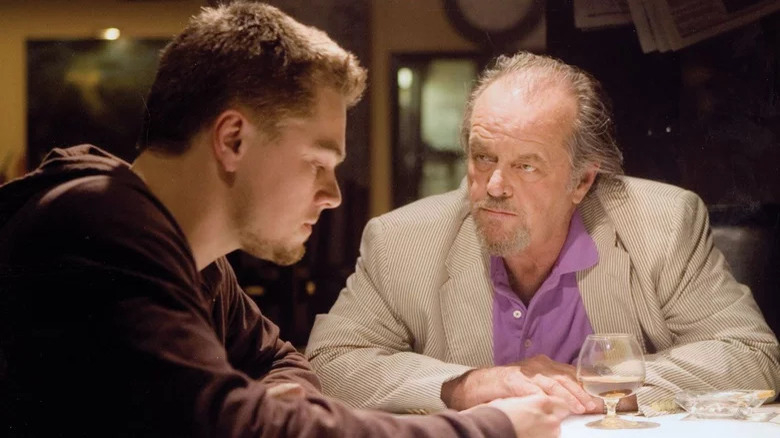
Martin Scorsese's filmmaking career has seen a number of masterful turns, from his early classics on lonely, violent men ("Taxi Driver" and "Raging Bull") to his explorations of the worlds of faith (like "Kundun" and "Silence") and more, but he's best known for his examinations of mafia life in films like "Goodfellas" and "Casino." "The Departed," his only best director Oscar win, sees Boston-based Irish Mob boss Frank Costello (Jack Nicholson) plant Colin Sullivan (Matt Damon) within the Special Investigations Unit as the authorities place Billy Costigan (Leonardo DiCaprio) within the mob. Each infiltrator has to find the other while keeping himself hidden, or else he's going to have a bad time.
The film begins by growing that set up until Sullivan gets established and Costigan gets put in jail as part of the ruse (he has to look like he's fallen out of the sphere of the law and into a life of crime). The jail cell door closes at around the 18 minute mark, a clear signal to the audience that all the pieces are in play and our two moles are in their respective organizations. The whole film is a complex set of chess maneuvers, and Scorsese's choice to employ the title card to set it all off signals that 18 minutes into the film, all that preceded was nothing in comparison to what's coming.
The Empty Man
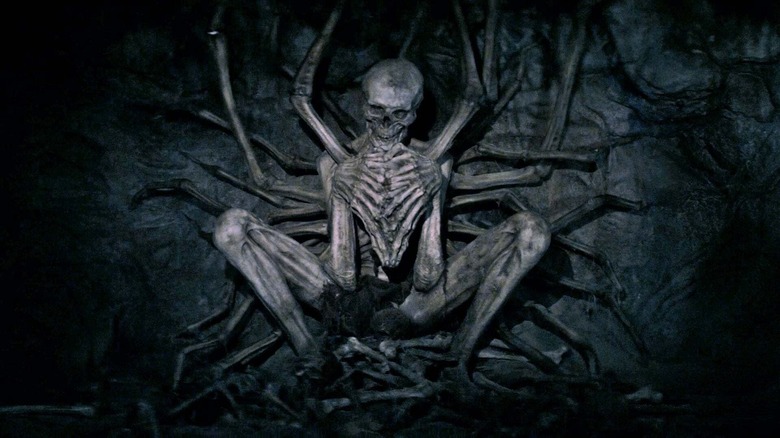
"The Empty Man" begins with what is effectively a short film. It follows a group of friends in 1995 travelling deep into the Himalayan mountains, where one of their number stumbles upon an otherworldly skeleton in a cave. They've awakened something, and let's just say they don't all make it. The title card drops at the 22 minute mark, after the doom of these initial adventurers has unfolded. Fast forward to 2018, where detective James Lasombra sets out to investigate the disappearance of his neighbor's daughter, it sets in motion a train of events that vastly changes James' world and which threatens to impact the world as we know it, all for an entity known as the Empty Man.
The title card drop cleanly separates the prologue and the rest of the film (don't worry, they do connect). It sets up what feels like a fresh start for a new story, alongside a mystery: what does it mean, and how does it connect to the rabbit-hole investigation our protagonist goes down in the course of the film? What is this "Empty Man" and does it relate to whatever that was in the film's prologue? It sets the audience up for a dangerous supernatural experience, and one whose connection doesn't become clear until the film's final act.
Friday The 13th (2009)
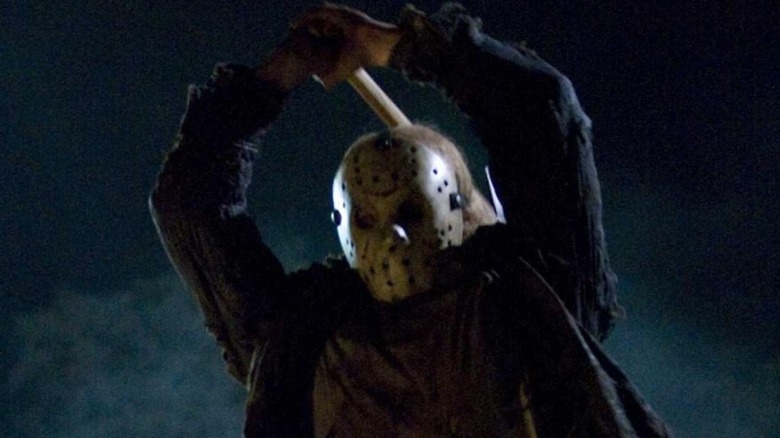
Horror fans the world over know the story of Jason Voorhees, the (eventually) hockey mask-clad murderer who stalks Camp Crystal Lake to kill unsuspecting teens. 2009's "Friday the 13th" follows dutiful brother Clay as he searches Crystal Lake's woods for his missing sister Whitney, only to find the remains of the infamous camp -- and the killer to boot. The long intro builds to a group of friends visiting the camp around 20 years after Jason sees his mother murdered (at the end of the original film).
Jason here is a lean, mean, murder machine, and he quickly dispatches everyone save Whitney (though her fate is initially unknown). At the 23 minute mark, the title card drops immediately after a brutal spree. The opening is a successful reboot of the prior films, leading to a violent and aggressive reimagining of Jason Voorhees and setting us up for the inevitable conflict between Clay and Jason. Its use here demarcates that all we've seen is mere prologue, while highlighting a villain that will prove violent and formidable. It also adds mystery, as the title drop interrupts the spree before we see how it ends.
Fresh
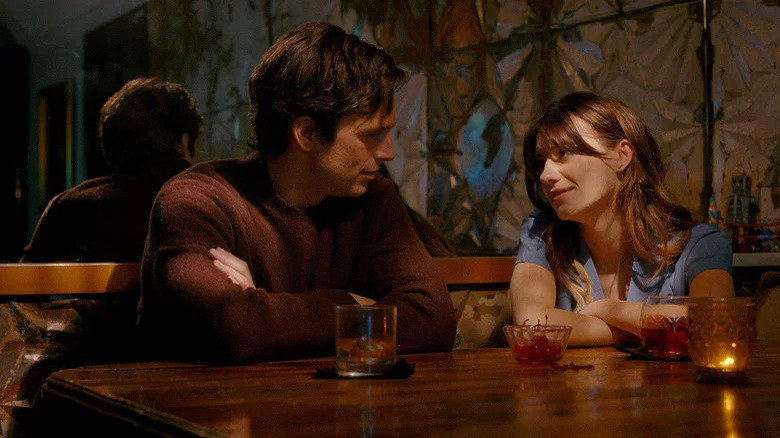
In "Fresh," single lady Noa finally meets the supposedly perfect man in Steve. Long frustrated with the dating scene, she takes a risk and gives Steve her number. They have a great first date, so Noa accepts his sudden invitation to an isolated romantic getaway for a weekend. It's a lovely time ... at least until she finds herself drugged and chained in a concrete room in Steve's fortress-like house. Turns out Steve is an entrepreneur of an eerie sort, providing unconventional meat for an "elite" food delivery service.
In the middle of what seems to be a good date inside Steve's isolated dwelling, he gives Noa a spiked drink. It begins to knock her out and, as she starts to lose consciousness, the title card finally drops at around the 33rd minute. It highlights the dramatic tone shift from where it looked like the film was going into where it does go: a much darker story is in play. It also underscores Steve's betrayal of Noa, and as she goes dark and we pull back to see a standing Steve with the title against the wall it establishes that Steve has all the power ... or at least, he thinks he does.
RRR
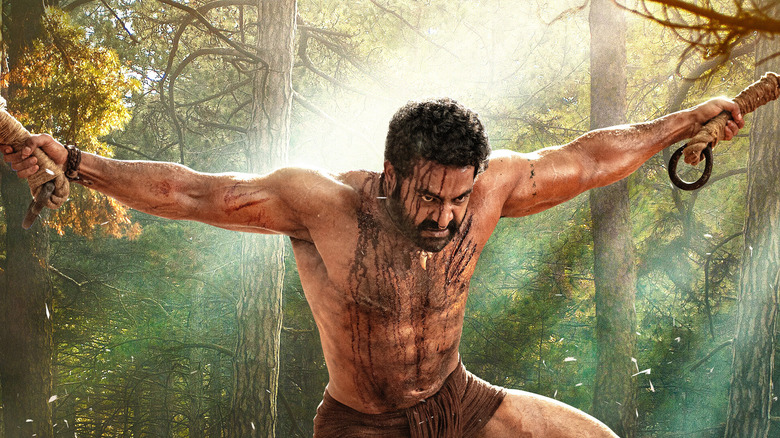
India's independence movement has had a host of impactful players, inspirational freedom fighters who have sparked serious Oscar-winning biopics across the pond ... or you can mythologize famous Indian freedom fighters in an action epic where they come to embody classic figures in Hindo folklore history. "RRR" showcases Gond tribal leader Komaram Bheem and revolutionary Alluri Sitarama Raju as they wage war against British rule. It's an absolute riot.
The pair meet by coincidence: a fiery train crash puts a small boy in danger below a bridge. With Komaram Bheem on the shore below and Alluri Raju atop the bridge, the pair lock eyes from far away and -- in an elaborate bit of choreography involving a horse, a motorcycle, a flag, and a rope -- the pair save the boy, meeting as they lock arms under the bridge. At around the 40 minute mark the title credits finally hit.
At its core, "RRR" is an action-fantasy revolutionary bromance between Raju and Bheem, and the title card drop (after a stunning amount of time and a larger-than-life action sequence) punctuates the importance of their meeting and embrace. It tells you everything you need to know about just how pivotal that moment was.
Drive My Car
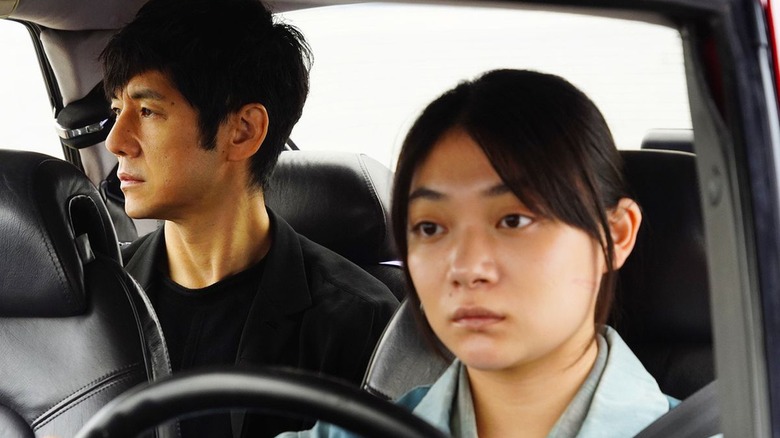
Ryûsuke Hamaguchi's "Drive My Car" follows widowed director Yusuke Kafuku en route to direct "Uncle Vanya" at a theater festival in Hiroshima. It's his return to directing after the death of his wife rendered him unable to work on a prior iteration of the play two years' prior. He's forced to work through his long-stagnant trauma with the help of his driver, Misaki Watari, in a beautiful and moving adaptation of Murakami's well-regarded short story.
Yusuke sets out on the road to direct "Uncle Vanya," a pivotal moment in both taking agency over his life once again and in his dealing with grief and the complexity of his past. At the 41 minute mark, he starts driving ... roll credit sequence. Interestingly enough, the film's actual title isn't shown until the entirety of the film is concluded; the initial credit sequence simply introduces the film's cast and crew.
Following the long introduction, the opening credits mark the point where the stagnation of Yusuke's prior two years is finally interrupted, and the separation between the initial credits and the concluding title card adds a further set of book ends to his journey. It screams at the audience that his journey is truly beginning and, stronger still, that his transformative path isn't over until it's truly over.
Mandy
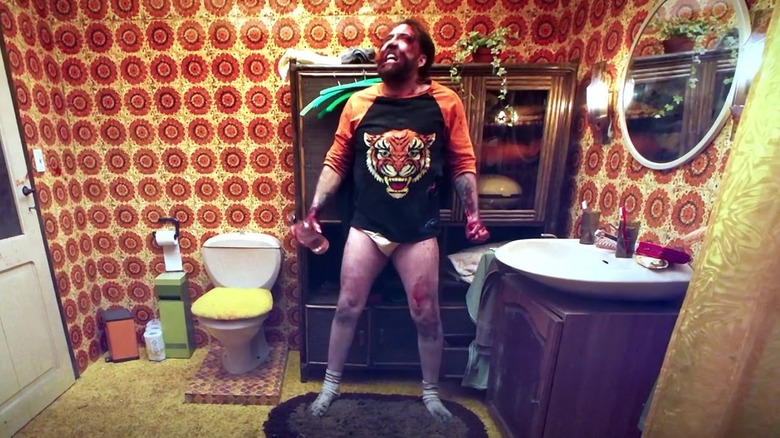
Red Miller and Mandy Bloom live in an isolated home in the Pacific Northwest. The pair are madly in love, but when the cult of ex-hippie songster Jeremiah Sand set their eyes on Mandy and break into Red's home, it sets in motion a violent and visually stylish campaign of revenge. "Mandy" is a wonderful, thrilling, memorable action-horror epic, and it's also unique for boasting a uniquely late title card placement -- a whopping 75 minutes into the film.
After losing Mandy, Red goes to the bathroom, drinks himself silly, and freaks out in a scene you just have to see. Gathering his cool, he returns to a former comrade to retrieve a weapon from his old life. Moments later he's in a forge, pouring metal to create an incredible axe that he finishes and brandishes, the blade shining brightly. Cue the title card. The crux of the film is Red's campaign of bloody revenge against the cult and a set of nigh-demonic bikers, answering the question "what if The Terminator battle-axed his way through the Cenobites?"
Apocalypse Now
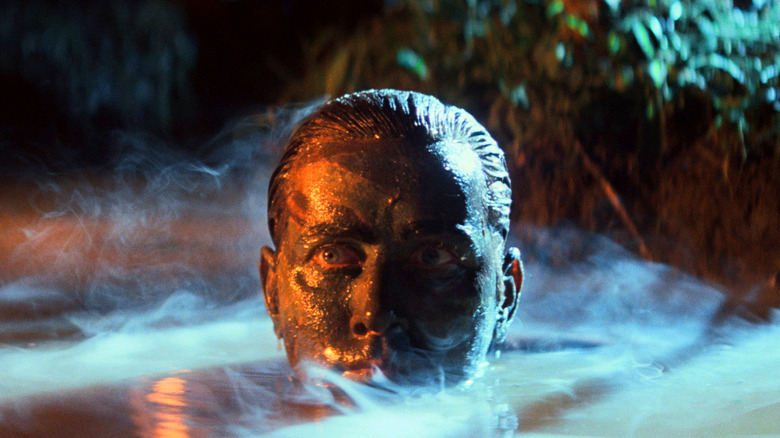
Frances Ford Coppola's Vietnam War epic "Apocalypse Now" follows Captain Willard (Martin Sheen) and a boatful of soldiers as they undergo a dangerous mission: the assassination of Colonel Kurtz, a now renegade officer who has reportedly gone insane. The crew must travel into dangerous territory in a war epic that really captures the psychological toll of the Vietnam War. It's a stylish, visually stunning, intense outing alongside being among the greatest entries on the crowded list of excellent Vietnam War films. Beyond all this, the film also boasts an interesting approach to a title card, and one that comes in at a novel time.
The film itself doesn't have a credits sequence. In a sense, a title card doesn't appear anywhere. The film's title, however, does; as Captain Willard and company finally approach Kurtz' hideout at the 1 hour and 48 minute mark, the audience can see graffiti on a nearby structure: "Our Motto: Apocalypse Now!" It's a great representation of Colonel Kurtz, who had racked up atrocities to the point that high command couldn't have him growing rogue, and one that befits the film's pure cynical tone about war.
Call Me By Your Name
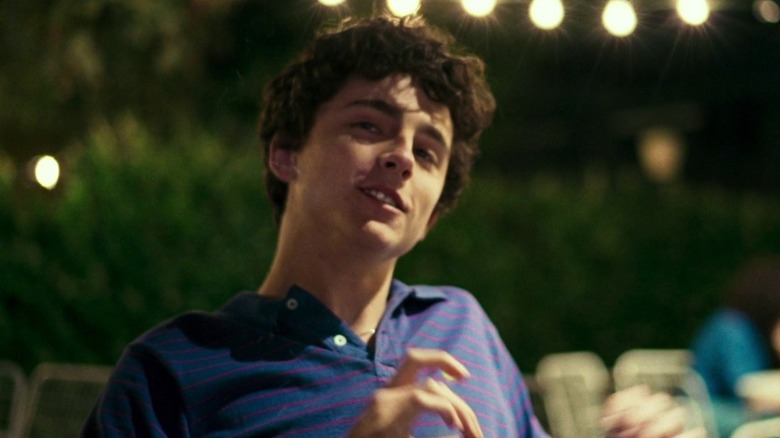
Italy, 1983. Oliver is a doctoral student who comes to work with Mr. Perlman, the father of 17-year-old Elio Perlman in the throes of his self-discovery as a young man. The beautiful Italian villa and the sun-drenched summer surroundings begin to facilitate a burgeoning forbidden romance between Elio and the much older Oliver. Like all forbidden summer flings, it can't last ... much to the passionate young Elio's deep sadness. It's a stunningly poignant coming-of-age drama from director Luca Guadagnino, and it's also one of the finest examples of a heartbreaking final scene punctuated by a smart title card placement.
In the film, Elio and Oliver visit Bergamo together, shortly before Oliver returns to the U.S. Months later, Oliver calls Elio's family to tell them that he's now engaged to marry a woman. A distraught Elio speaks on the phone to Oliver, who refuses to deny what happened between them but who is, for personal reasons, moving on from his authentic feelings. The call concludes, and the audience sees Elio staring into the fire as his heart breaks (away from the prying eyes of his family). After a long, beautiful, poignant take, we see the credits at the 2 hour, 8 minute mark. The title, "Call Me By Your Name," recalls the pair's connection (reflecting a continued romantic signal they'd established), and its presence here amplifies Elio's deep heartbreak.
The Dark Knight
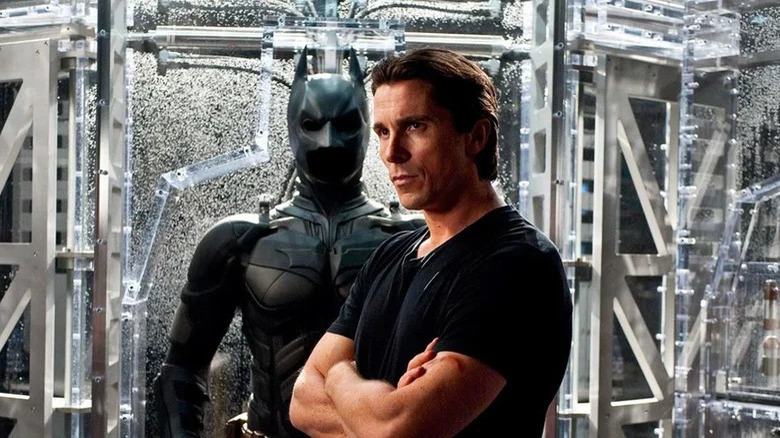
Christopher Nolan is a singular filmmaker, whose work spans neo-noir titles such as "Following" and "Memento," science-fiction movies like "Inception" and "Interstellar," superhero epics (the "Dark Knight Trilogy," anyone?) and war dramas like "Dunkirk." As a filmmaker Nolan has a number of characteristic tells, and one of his signature directorial traits is a propensity to put title cards in an unconventional place: the film's end.
While "Dunkirk" has the title card right up front, "Inception" places the title card at the tail end of 2 hours and 20 minutes, after the infamously mysterious spinning top. "Tenet" rather appropriately places the title card after the rest of the credits, at the 2 hour, 29 minute mark. But for this entry, let's look at Nolan's Oscar-winning superhero entry "The Dark Knight," a film that opens on a dark Batman logo coming through blue-tinted flames.Following a Batman that has to contend with the Joker's brand of chaos, alongside the transformation of the once bastion of justice Harvey Dent into the scarred criminal Two Face, the film ends on a stark note. Its title card finally comes at the 2 hours and 24 minute mark, following the film's conclusion where Batman accepts the blame for Two Face's crimes in order to preserve the legacy of Harvey Dent. The film closes on Lieutenant James Gordon's monologue about Batman's vigilantism as Gotham's "silent guardian, a watchful protector, a dark knight." Cut to black, roll title card.
Read this next: The Best Movies Streaming Right Now: Malignant, A Hero, And More
The post Movies Where the Title Card Appears Surprisingly Late appeared first on /Film.
What We Want To See In Stranger Things' Final Season
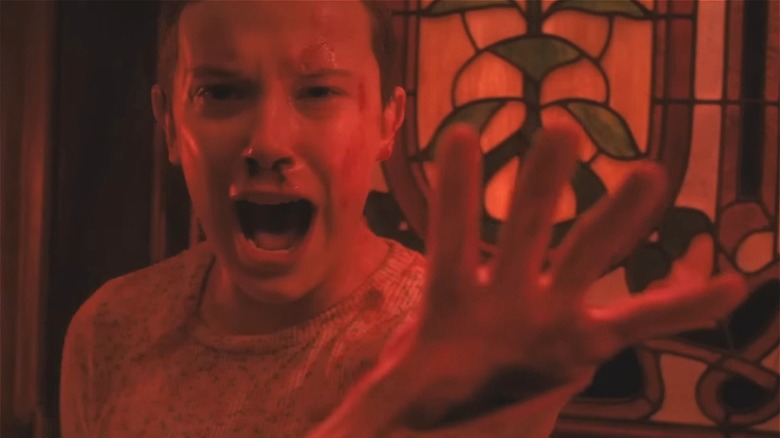
Warning! Major spoilers ahead for "Stranger Things" season 4 (volumes 1 and 2 ahead).
There's a lot to unpack with regard to the rollercoaster of a season finale of "Stranger Things" volume 2. This season's final episode, "The Piggyback," which is longer than a feature-length film, and the episode preceding it, "Papa," sets up some hefty exposition and developments to set up the stage for a grand finish. You can check out a spoiler-free review of volume 2 by /Film's Chris Evangelista, who touches upon the highs and lows of the final episodes and how they fare, as a whole.
However, I will not be dissecting the final episodes in the post, but instead will make an attempt to look into how season 5 of "Stranger Things" — which will be serving as the final season for the show — could potentially play out based on the events of the finale. There were some epic moments and high points, for sure, while other moments felt contrived and did not quite pay off the way audiences would expect them to.
Nonetheless, here's what we absolutely want to see unfolding in the final season of "Stranger Things," especially in terms of the fates of the characters, and the mysterious town of Hawkins.
The Details Of Hawkins Gradually Turning Into Upside Down 2.0
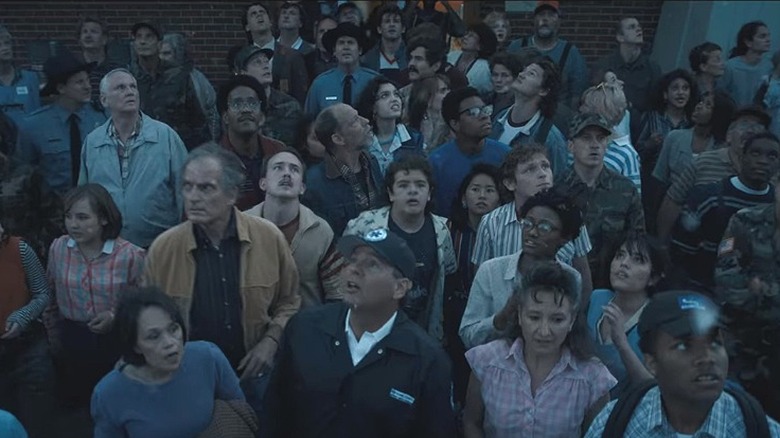
The worst is definitely not over — in Vecna's (Jamie Campbell Bower) words, this is "just the beginning ... of the end." However, Hawkins is in the process of being transformed into a real-world version of the Upside Down, thanks to Vecna successfully opening the four gates via the deaths of the four teenagers (although Max is thankfully alive, her heart did stop for over a minute). I'm not sure how the authorities are spinning this near-apocalyptic event as a high-magnitude earthquake, as the town is almost unrecognizable after the portals opened, with smoke billowing from the cracks.
The Duffer Brothers previously mentioned that season 5 will have a time jump, partly to explain the accelerated ages of the cast, who clearly do not look like kids anymore. Judging by the events that occurred in the final episodes, leaving several injured and missing, there could be a time jump of a few months or a year, during which, Vecna (who is still alive, by the way) could come back stronger and unleash the monstrous horrors of the Upside Down on to the real-world.
This would be a great opportunity to explain how the lives of the common townsfolk are affected by these events, and whether they're still buying the whole Hellfire Club conspiracy, with Eddie Munson (Joseph Quinn) being responsible for everything. Speaking of Eddie ...
Eddie Munson Should Be Publicly Recognized As A Hero
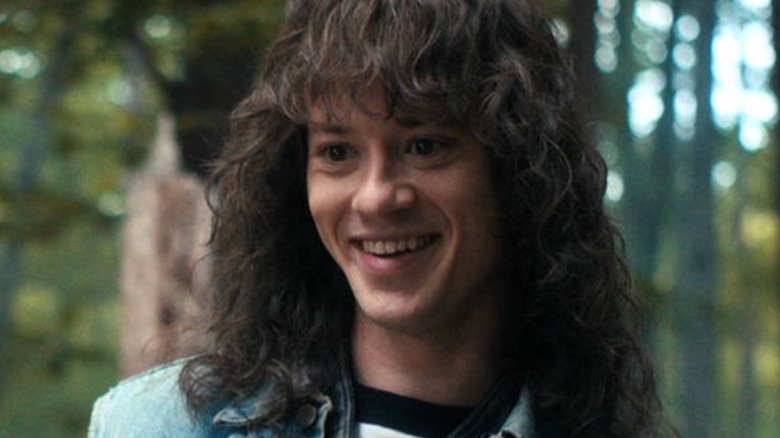
While the "Stranger Things" cast and crew did hint at some deaths this season, the only major character who dies is Eddie (well, there's also Dr. Brenner, but he was single-handedly responsible for a lot of death and destruction, so it's a bit hard to empathize). While I will not plunge into a rant about how unjustified and contrived his death was, the character definitely deserved better, as he sacrificed himself for a town that blindly hated him until the very end.
Eddie's name being cleared is the least season 5 could do to honor the character, and it would be great to at least have one scene in which some of the characters, including Mike (Finn Wolfhard), Nancy (Natalia Dyer), Steve (Joe Keery), and Robin (Maya Hawke), discuss Eddie's sacrifice and display some appropriate emotion, as they spent a considerable time with Eddie throughout season 4. This aspect was completely sidelined in the final episode, as Dustin (Gaten Matarazzo) seemed to be the only one who remotely cared about Eddie's death, relaying the devastating news in an emotional scene to the deceased's uncle. Apart from this, the town seems to be allowing itself to be engulfed by paranoia, and it is likely that they will continue to label Eddie as a Satan-worshipper/cult leader in the face of horrors they do not understand. Hence, a memorial of sorts held in Eddie's name would be great, thank you very much.
Answers To The Pivotal Max Question

Max underwent unimaginable horrors during her confrontations with Vecna, and the poor girl would have died, had Eleven (Millie Bobby Brown) not stepped in and attempted to bring her back. Despite being alive, Max is in a coma, with several broken limbs and no eyesight. What's worse, when El reaches inside her mind, she finds it empty, begging the question: Where is Max, and is she safe?
Although we have no idea what Vecna is up to right now, Will (Noah Schnapp) says that he can feel his presence and that he's hurting, but he will soon be back and fulfill his diabolical plan. While it is possible that Vecna has a hold on Max's psyche, is it possible that she is simply hiding, as Will did from the Demogorgon in season 1? Things are not looking too great for Max right now, as her physical body is extremely injured, while her psyche might be stuck navigating a mental dimension she had no idea about. Nevertheless, the show needs to find a way to bring her back, and we might see more of Eleven diving into her mind to help her out.
The Space-Time Mechanics Of The Godforsaken Dimension
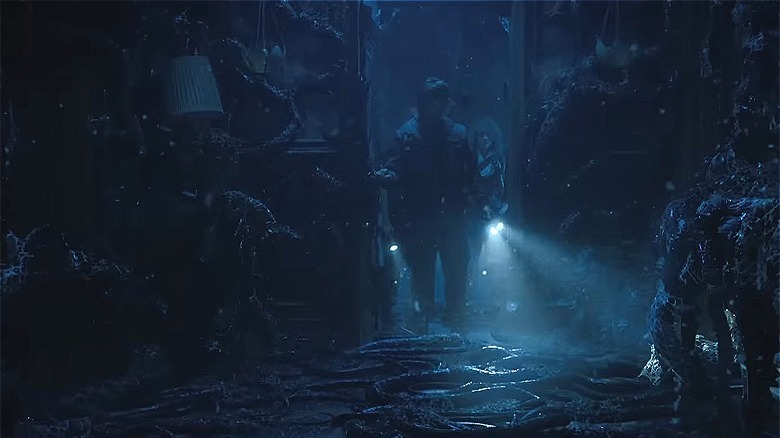
Vecna/Henry/One offers some lengthy exposition to Eleven while he has her tied up: after she yeeted him into the Upside Down, he became an "explorer," explaining that the dimension was untouched by humanity in any way, with the already-existing Demogorgons/Demodogs freely roaming the place. Eventually, he came into contact with the sentient particle that the Russians referred to as "the shadow," which he reaches out to and shapes into the Mind Flayer. This makes sense, as the Mind Flayer is also known as the Shadow Monster, and it was Vecna pulling the strings all along.
An important element of the plot that was not addressed in season 4 is that time had completely stopped in the Upside Down for some reason after Will's disappearance in season 1. While Vecna can control the flow of time (he is shown slowing down the grandfather clock as a child), has he also been altering the Upside Down to resemble the real Hawkins all these years?
There must be some integral reason behind time stopping in the Upside Down after Will's disappearance, potentially revealing why Will can still sense Vecna's presence and has a connection to his mind after all these years.
The Gang Absolutely Demolishing Vecna
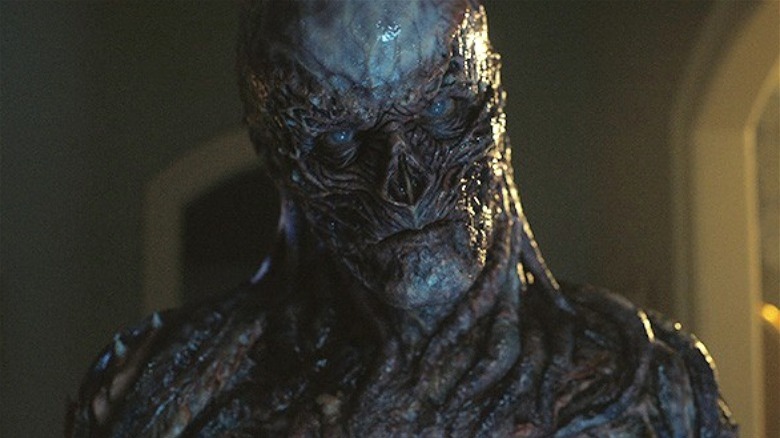
Things are only bound to go downhill from here, per Brenner's bleak prediction of Hawkins' future and the visions Vecna chose to show Nancy. The creatures will run freely around Hawkins, and the gang will hopefully be able to put a stop to things getting worse before it is too late. Vecna won't stop until he has remade Hawkins, and the world, as per his twisted imagination, and it will take more than strength and bravado for the gang to kill the big baddie and close the portal for good (or better, destroy the dimension altogether).
There are other players involved in the situation too: let's not forget the military dude Sullivan, who wanted to have Eleven killed as he believes she is behind the murders in Hawkins. While the Russian prison in which the shadow and the creatures were held has been dealt with, for now, it is unclear whether there are more monsters locked up around the world for experimentation purposes, connected to the hive mind.
There might be a few potential character deaths lurking around the corner, based on the warning issued by the Duffer Brothers to not expect a traditional happy ending by the end of the show, so I am guessing blood, trauma, and tears will once again be a part of the equation.
Joyce And Hopper Going On Their Damn Date
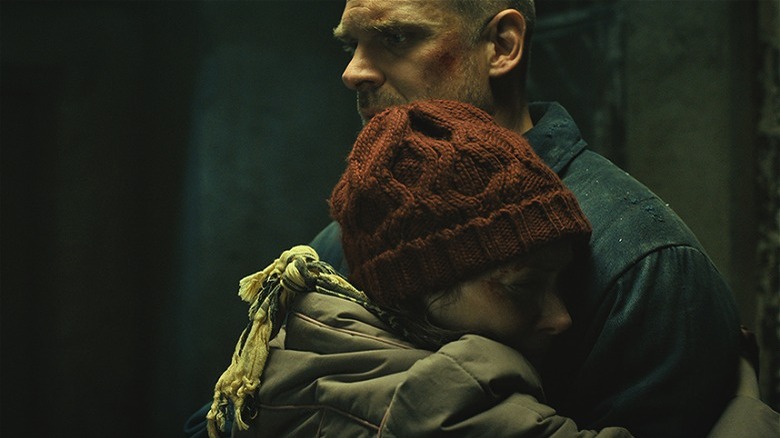
Hopper (David Harbor) and Joyce (Winona Ryder) finally had a romantic moment that was long overdue, before being cut short by the overwhelmingly bleak directions things were heading towards. Now they're reunited, sure, but given that Hawkins has now fallen, and bits of ash are now floating in the air, it is unlikely that the two can go on the date they had planned anytime soon. Hopefully, once the catastrophe is over, the two can finally spend time together in peace without worrying about the kids fighting a tentacled monster on their own. Let them have lasagna with a bottle of chianti, or whatever they like, please.
Everyone Living Out Their Lives (And Dreams), In Peace
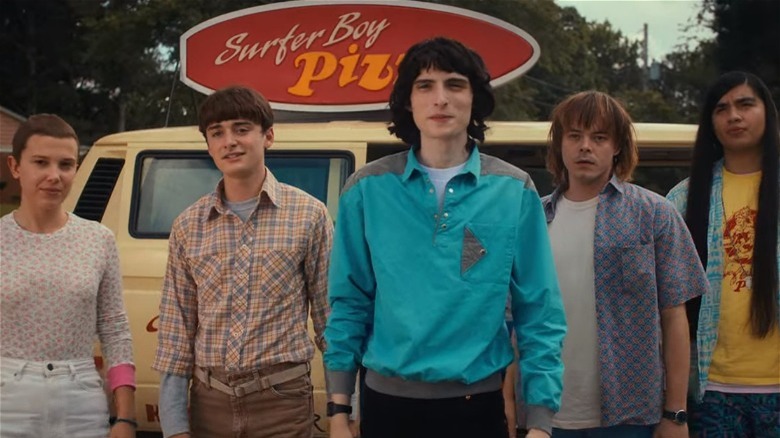
Although things cannot be overly positive at the end of "Stranger Things," everyone in the gang deserves to be able to heal from these traumatic events and move forward. Will shouldn't have to feel alienated due to his sexuality, and the show should absolutely grant him the safe space he deserves. The Nancy, Jonathan, and Steve storyline might be tackled in the next season, and I'm hoping it will be handled in a way that does not do a disservice to any of the characters and their personal agencies.
Eleven has been made to feel different all her life, and the poor kid deserves a break from it all, without having to give in to the trappings of "normalcy." The same goes for everyone else — Robin, Dustin, Lucas, Max, Erica, and Mike — and one can hope that they are able to actualize their respective dreams, whatever they might entail. We might end up losing a character or two before we reach this juncture, leaving an inevitable bittersweet taste during the season 5 finale. At this point, one can only root for these beloved characters and hope against hope.
Volume 2 of "Stranger Things," season 4, is currently streaming on Netflix.
Read this next: The Horror Movies We Can't Wait To See In 2022
The post What We Want To See In Stranger Things' Final Season appeared first on /Film.
20 Movies That'll Remind You the Government Can’t Be Trusted
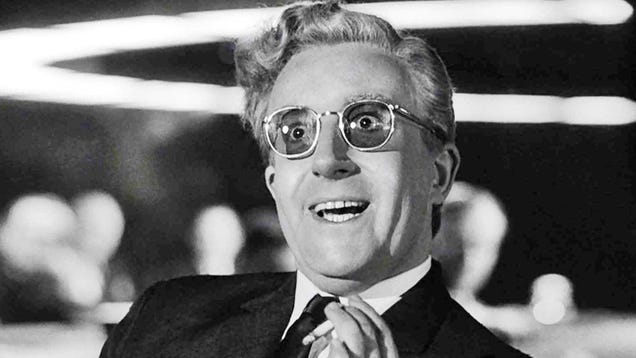
Governments lie. They cheat. They steal. Sometimes the blame comes from within: corrupt individuals who’d conned their ways into the halls of power with no moral compass beyond their own self-aggrandizement. Sometimes, the fault lies within ourselves: We’re drawn to populist politicians who tell us what we want to…
The best 4th of July tech sales we could find
Between the July 4th holiday and Amazon Prime Day coming up in a couple of weeks, there are a bunch of tech deals available right now. Solo Stove's Independence Day sale knocks up to 45 percent off fire pits, while our favorite ThermoWorks food thermometer is down to only $79. Early Prime Day sales bring Eero 6 router packs and Blink security camera kits down to record-low prices, and you can still pick up a Google Nest WiFi router for as low as $115. Here are the best 4th of July tech sales we could find.
Apple Watch Series 7
Most colors of the Apple Watch Series 7 are down to $329 at Amazon, or $80 off their normal price. This is our current favorite smartwatch and we gave it a score of 90 for its larger display, faster charging and handy watchOS features.
Buy Series 7 at Amazon - $329Amazon Eero 6
Amazon has discounted most Eero 6 systems ahead of Prime Day. If you're a Prime member, you can snag the Eero 6 WiFi system for as low as $71, the Eero 6+ for as little as $90, the Eero Pro 6 starting at $148 and the Eero Pro 6E for only $179. These are some of the best prices we've seen on all of these WiFi 6 systems, especially for the Eero 6+ and Eero Pro 6E, both of which just came out earlier this year.
Buy Eero 6 (Prime exclusive) at Amazon - $71Buy Eero 6+ (Prime exclusive) at Amazon - $90Buy Eero Pro 6 (Prime exclusive) at Amazon - $148Buy Eero Pro 6E (Prime exclusive) at Amazon - $179Echo Show 5 + Ring Doorbell bundle
Today is the last day Prime members can get a bundle with the Echo Show 5 and the Ring Video Doorbell for only $85. That's 54 percent off what the pack would normally cost, so this is a solid deal if you're looking to add another level of security to your home. The smart doorbell will show you who's outside your home and the Echo Show 5 can show you the feed from the doorbell's camera.
Buy Echo Show 5 bundle (Prime exclusive) at Amazon - $85Google Nest WiFi
A number of Google Nest WiFi packs are on sale right now. You can pick up one router for $115 or a three-pack with one router and two access points for $199. We like this system for its minimalist design, easy setup and built-in Google Assistant smart speaker.
Buy Nest WiFi (1 router) at Amazon - $115Buy Nest WiFi (1 router, 2 points) at Amazon - $199Solo Stove
Solo Stove's latest sale knocks up to 45 percent off fire pits, so you can grab one for as low as $200. The Ranger is the cheapest of the bunch, followed by the midsized Bonfire for $220. Both of those are fairly portable, but if you want the biggest possible fire pit for your backyard, you can pick up the 38-pound Yukon for $400.
Shop Solo Stove July 4th saleSonos refurbished sale
Sonos has discounted a bunch of refurbished devices again, bringing many of them down to the best prices we've seen. A refurbished Arc soundbar is $360 off and down to $540 while the refurbished Sonos One SL is on sale for $119.
Shop Sonos refurbished saleSamsung 980 Pro (1TB)
Samsung's 980 Pro SSD is 33 percent off and down to $140, which is one of the best prices we've seen. It earned a spot in our PS5 SSD guide for its reliability, compact, M.2 form factor and read speeds up to 7,000 MB/s. You will need a heatsink to use it with the PS5, but you can grab a bundle that includes one with the drive for only $170.
Buy Samsung 980 Pro (1TB) at Amazon - $140Buy Samsung 980 Pro (1TB with heatsink) at Amazon - $170Blink Indoor and Outdoor cameras
Prime members can save big on Blink Indoor and Outdoor cameras ahead of Prime Day. The Indoor camera kits start at $55 while the Outdoor kits start at $60. Plus, the Blink Mini wired security camera is on sale for $30 while the Blink Video Doorbell is down to only $35.
Buy Blink Indoor (Prime exclusive) at Amazon - $55Buy Blink Outdoor (Prime exclusive) at Amazon - $60Buy Blink Mini (Prime exclusive) at Amazon - $30Buy Blink Video Doorbell (Prime exclusive) at Amazon - $35Anova Precision Cooker Nano
Anova's Precision Cooker Nano sous vide machine is on sale for $99 right now, or 34 percent off its normal rate. This machine earned a spot on our list of favorite kitchen gadgets because it combines affordability and precision in a compact package. It can also connect via Bluetooth to your phone so you can control temperature and time settings from within its app.
Buy Precision Cooker Nano at Amazon - $99ThermoWorks Thermapen One
The red, white and blue colors of the Thermapen One are down to $79 for the Independence Day holiday. This is one of our favorite instant-read thermometers for cooking thanks to its fast readings, improved accuracy and bright display.
Buy Thermapen One at ThermoWorks - $79Wahoo Fitness sale
In a rare sale, Wahoo Fitness has knocked up to 25 percent off its devices, from pedals to full bikes. You can pick up pedals for as low as $120, while the Elemnt Bolt bike computer is down to $240 and the Kickr smart trainer is on sale for $960.
Shop Wahoo saleSatechi July 4th sale
Through July 4th, you can get 20 percent off sitewide at Satechi with the code JULY20 at checkout. That makes it a good time to grab a USB-C hub for your laptop, a new wireless keyboard or a charging stand for your phone.
Shop Satechi July 4th saleFollow @EngadgetDeals on Twitter and subscribe to the Engadget Deals newsletter for the latest tech deals and buying advice.
3D Moments That Made These Horror Movies More Hilarious Than Terrifying
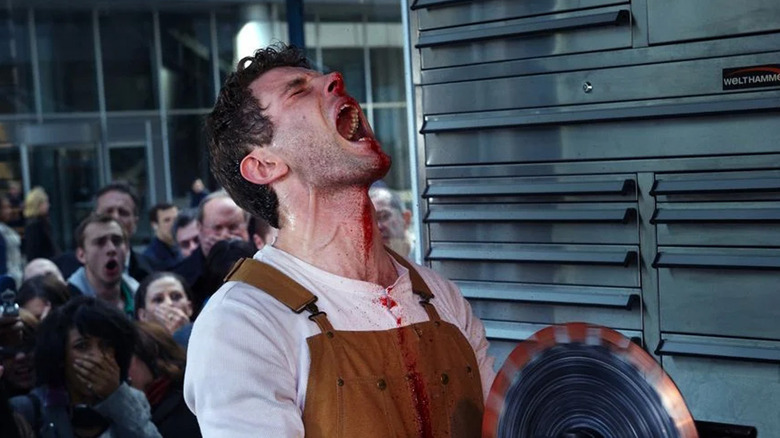
It's no secret that 3D just doesn't work in horror movies. Often considered a wacky gimmick, the addition of 3D to a serious horror flick doesn't just do nothing -- it actively works against the film's efforts to build tension and atmosphere.
Why doesn't 3D work in horror movies? Well, as a big-screen spectacle, it often undercuts what a horror film should be all about: heightened emotions. Whether it's the pop-out circular saws of "Saw 3D" or the weird 3D specters of "Amityville 3D," the technology just doesn't seem to fit with the fright factor. In fact, it often pulls the audience out of the moment, forcing us to experience some weird detail in eye-popping 3D instead of soaking in the moment or enjoying the terror of a good jump scare.
When you look at the horror flicks that have used 3D, it's no wonder we didn't exactly buy it. Let's put it this way: there's no way any of these films could be mistaken for the best horror movies ever made. But thanks to these 3D moments, they do at least have a dose of comedy.
JAWS 3-D (1983)
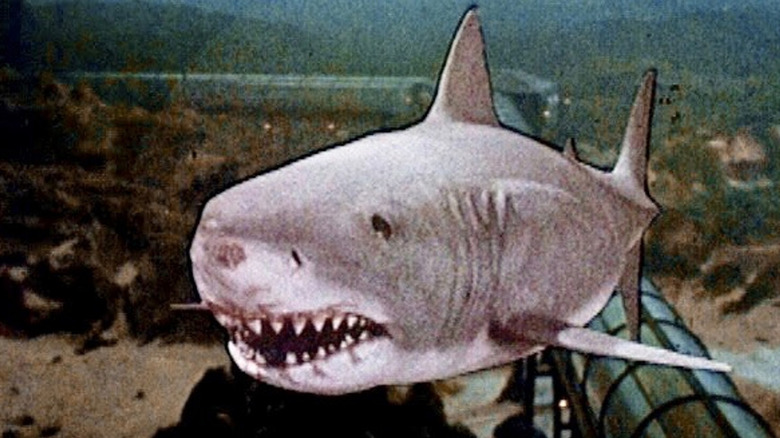
That's right, it's the infamous "Jaws 3-D." Not only a terrible 3D film, but also one that managed to single-handedly destroy the "Jaws" franchise. It was the worst of all the "Jaws" sequels ... at least, until "Jaws: The Revenge" came along.
In "Jaws 3D," a great white shark finds itself trapped in SeaWorld Orlando after following a trio of water skiers into the park. And yet even as all hell breaks loose around them, the park management is hell-bent on capitalizing on this new development. It's as terrible as it sounds, with effects to match, particularly in the movie's final scenes.
After trying to flush out the shark, Mike Brody (Dennis Quaid) and the gang head back to the SeaWorld Control Room, but it seems the shark has appeared in front of its conspicuously flimsy glass viewing window and smashed through the glass! It sounds far more terrifying than it is, as the film's 3D effects turn this otherwise mediocre scene into a moment of sheer hilarity.
Honestly, I can't believe this ever made it to the big screen. Sure, there are plenty of atrocious 3D moments throughout the film, but given that this is the film's climax, you'd think a bit more care would be put into getting it right. Instead, the scene is assembled with what I can only assume is the least amount of effort possible, culminating in a truly un-terrifying scene with a shark that looks like a cardboard cut-out, complete with a weird black outline and a glass-shattering effect that looks like a '90s PowerPoint transition.
Friday The 13th Part III 3D (1982)
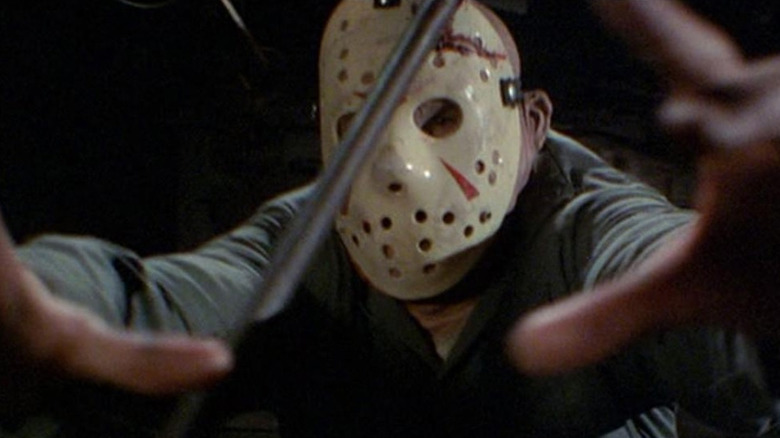
It's the film that gave Jason his iconic hockey mask, but "Friday the 13th Part III 3D" doesn't have much else going for it. Unfortunately, it's even worse when you take a closer look at some of the film's completely unnecessary 3D effects.
At various points throughout the film, we're treated to scenes of popcorn popping in glorious 3D, as well as, uh, a yo-yo going up and down? There's even one terrifying scene depicting a wallet being thrown toward the audience. Spooky!
The 3D moments run rampant in "Friday the 13th Part III 3D" with head-scratching regularity. And while some of the more brutal 3D scenes look okay, it seems that the filmmakers were more interested in the film's effects than its actor's performances. Larry Zerner, who played Shelly in the film, explained:
"It quickly became clear that most of the time, the performances didn't matter. When we were shooting the scene at the convenience store with the gang members and I had to throw a wallet at the camera, it was, 'Hit the camera!' Then, after ten takes it was 'Hit the camera, a**hole!'"
The result is an obvious focus on the effectiveness of the 3D scenes, most of which are peppered randomly throughout the movie with no real care about whether or not they heighten the terror. Instead it's reduced to a mere gimmick, with the most mundane of actions brought to the foreground in full 3D.
But there is one memorable moment when 3D is used to "enhance" the brutal horror. It comes when Jason crushes Rick's head with his bare hands, and his eyeball hilariously pops out at the audience. Behold: cinema!
The Final Destination (2009)
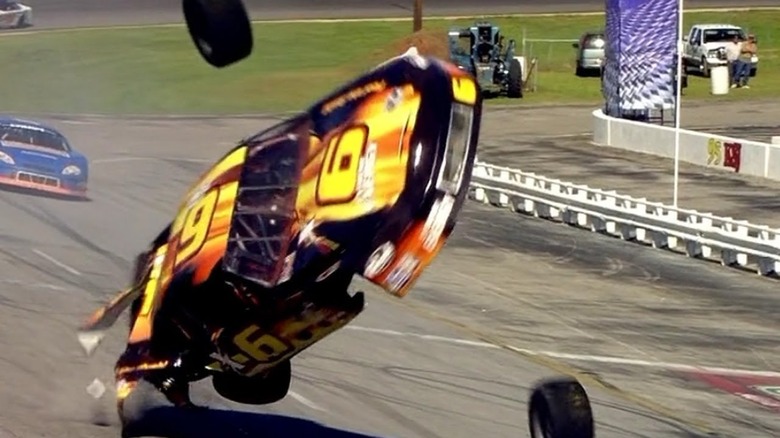
You can't cheat death ... but you can make it look even more eye-popping. "The Final Destination" is the franchise's first foray into 3D effects, and it sadly doesn't quite nail it. Sure, there's some fun to be had with its pop-out visuals, especially during the McKinley Speedway scenes, but the problem here is that the effects largely undermine the film's tension. In fact, I'd say they do away with it completely. Instead, the 3D scenes give the film a campy, schlocky quality that the series had previously avoided, if only by a narrow margin.
Producer Craig Perry said that he wanted the 3D to add depth to the film rather than just being used for the sake of it, because "having something pop out at the audience every four minutes gets boring." Unfortunately, that's exactly what happened, with all manner of objects and flying body parts shooting out of the screen with tired regularity.
The film's worst offender? That Speedway scene. It begins when a race car crash causes a tire to bounce into the spectator's stand -- zooming right past the audience's eye line, of course. But that's just the beginning. We get several minutes of exploding cars, sharp objects, and visceral splatter, all in glorious 3D. While upping the ante when it comes to the gore, it just feels over the top. Throw in those 3D effects and some straight-to-DVD quality visuals, and it becomes a lesson in how not to use 3D in a horror film.
Although "Final Destination 5" continued to use 3D effects, it was a much better film. The sequel veered away from "The Final Destination's" campy antics, returning to the franchise's signature style of heightened suspense. Death was back, in 3D, and it never looked better.
Freddy's Dead: The Final Nightmare (1991)
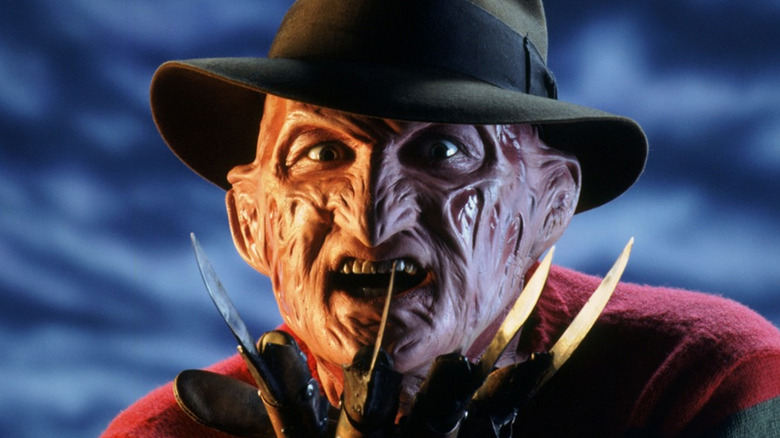
Now, this is a weird one. The majority of "Freddy's Dead: The Final Nightmare" isn't in 3D. But the film's final act takes a very meta swerve into 3D as its main character, Maggie (Liza Zane) pops on a pair of 3D glasses. The result is a 3D "Freddyvision" sequence that boggles the mind.
Entering into Freddy's mind by putting on the glasses, Maggie witnesses a collection of Freddy's memories: all the things that led to him becoming an immortal killer and stalker of dreams. It's an altogether weird ending, made even weirder by the fact that there's not much that really needs 3D during this sequence. We find out that Freddy was teased as a child, that he was abused by his foster father, that he self-harmed as a teen, and eventually murdered his wife as an adult.
This trip through Freddy's history didn't need the gimmick of 3D. "A Nightmare on Elm Street" fans were already sold on finding out more about Freddy's past, and these scenes really do give us a view into the killer's psyche that we've never seen before. In fact, they're some of the most compelling scenes of the entire movie, making the addition of 3D effects a real head-scratcher. Of course, the real transgressions come as we're heading into Freddy's brain, complete with 3D disembodied floating skulls circling around us.
Quite what possessed the filmmakers to go in this direction is an absolute mystery, but what follows is a solid history of Freddy Krueger that fans of the series will really dig -- if they can get past the very cheesy 3D effects, that is. An extra shout-out goes to Freddy's synapses for looking like a mass of long modeling balloons you'd expect to find at a children's party.
SAW 3D (2010)
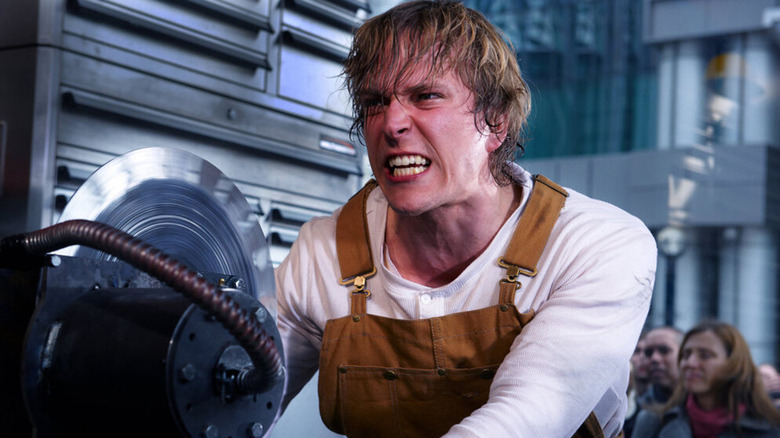
If any of these films were made for 3D, it's obviously the "Saw" movie, right? "Saw 3D" takes the increasingly gory premise of the "Saw" franchise and amps it up to 11 with a variety of bloody, gory traps that make the most of its 3D format.
Shot entirely in 3D, the film latches onto the 2010s' obsession with 3D movies, rendering all manner of objects, weapons, and human viscera in extreme detail as they fly out of the screen. And one of the worst offenders is that DIY store scene.
In the gory opening setpiece of a truly wild sequel, "Saw 3D" features one of the most bizarre traps we've seen to date. Brad and Ryan have been seeing the same woman, and they find themselves shackled to opposite ends of a workbench with their mutual acquaintance, Dina, suspended over them. With a ticking clock and a trio of circular saws, the pair must decide who lives and who dies. Set up in the window of a home improvement store, it's a modern day, slightly gorier edition of "Jerry Springer."
The idea that any Jigsaw killer would care about a random love triangle is pretty ridiculous, but not as much as the 3D effects themselves. First-person shots of the circular saws plunging towards the audience are crying out for the 3D treatment, but where the film aims to make us experience what it's like to be inside one of Jigsaw's traps, it just comes off as a thoroughly unscary gimmick. Throw in the 3D spatter of Dina's innards and we have a horrible and laughably bad scene that will make you wish every "Saw" film was as good as the first.
Still, you can almost respect the decision to try something new. Almost.
Amityville 3-D (1983)
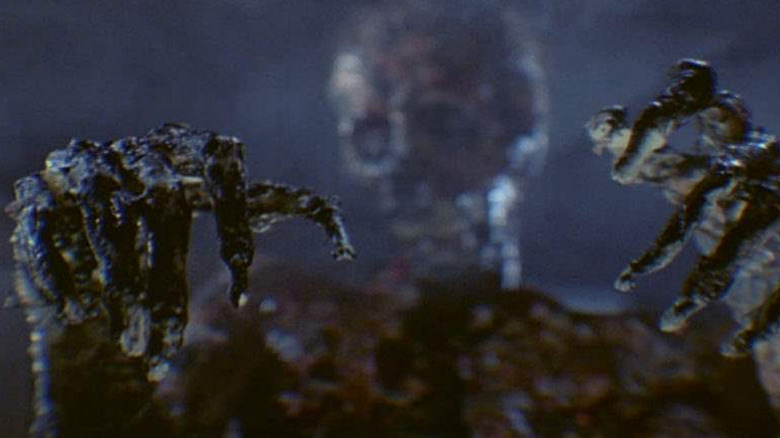
Now, this is one 3D horror film that makes absolutely no sense at all. "Amityville 3-D" came along around the same time as "Jaws 3-D" and "Friday the 13th Part III 3D" during the resurgence of 3D film in the early '80s. The trouble is ... "Amityville 3-D" has no business being a 3D film.
A classic haunted house kind of movie, "Amityville 3-D" is just about the worst possible kind of movie to try out those new-fangled 3D effects. It's essentially a sequel to "The Amityville Horror," even if it isn't exactly marketed as one.
Journalist John Baxter (Tony Roberts) moves into the infamous 112 Ocean Avenue, the now-iconic haunted house from the first film. But where previous installments took a more subtle approach to the supernatural, it's no surprise to find that "Amityville 3-D" is a bit more in your face.
Horrific visions are rendered in 3D space as John and his family encounter demons in their new home. The 3D effects add nothing, as you might imagine, to the usual haunted house tropes, and an altogether cheesy finale sees flying and exploding objects taking out paranormal investigators. The accidental comedy of the effects pulls us out of the film entirely as the whole thing devolves into farce. There's really no redeeming feature when it comes to this film's 3D, with the finale acting as a reminder of why the first movie was so terrifying: it's everything "Amityville 3-D" isn't.
The house imploding is a neat metaphor for the movie itself, a box office flop that was widely panned upon its release. In fact, the franchise wouldn't return to theaters until 2005. Quite the legacy for a bona fide 3D nightmare.
My Soul To Take (2010)
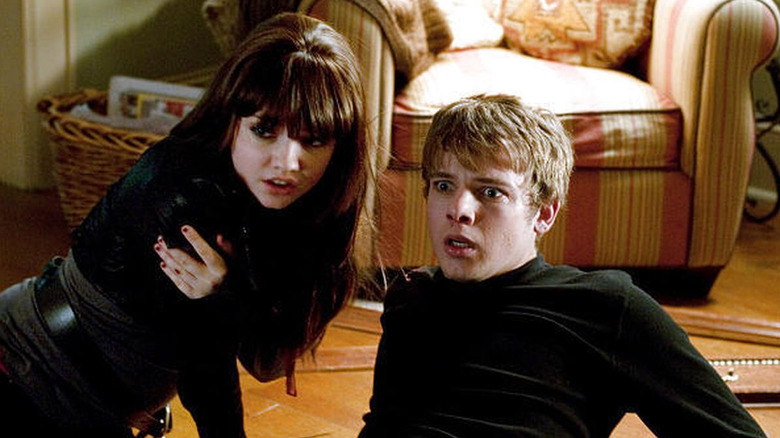
I hate to speak ill of a horror legend, but Wes Craven's "My Soul to Take" is just terrible. It tells the story of seven teenagers who have been chosen to die on the anniversary of a serial killer's death. Why? It's believed that they might possess parts of his soul, since the killer had Dissociative Identity Disorder.
Honestly, there's not much that could save this one. A dull, lifeless script is hashed out half-heartedly across the film's 107-minute runtime, with formulaic story beats that really aren't helped at all by the lackluster 3D effects. "My Soul to Take" wasn't even shot in 3D; it was converted in post-production to capitalize on the rising popularity of 3D films.
The 3D effects go relatively unnoticed, which is sort of a blessing. After all, the film never distracts from the atmosphere with eye-popping visuals. But it also does little to justify a 3D conversion in the first place. Sure, there are some moments that look quite neat; one particular shot looking through a slatted closet door makes for an interesting discussion of immersive 3D techniques. But since it lasts no more than a few seconds, it's not really worth the hassle of converting to 3D, and the movie was never originally intended to be presented that way at all.
"It was done totally as a 2D film, we never thought of 3D," said Craven at the time. "They approached me, and said, 'How about 3D? We would love to do it in 3D.'"
The most frustrating thing about "My Soul to Take" is that it was Wes Craven's final film. Instead of going out on a high note, the legendary horror filmmaker crossed the finish line with a film that's just a dull, withering mess. And no amount of 3D effects was going to make that any better.
Night Of The Living Dead 3D (2006)
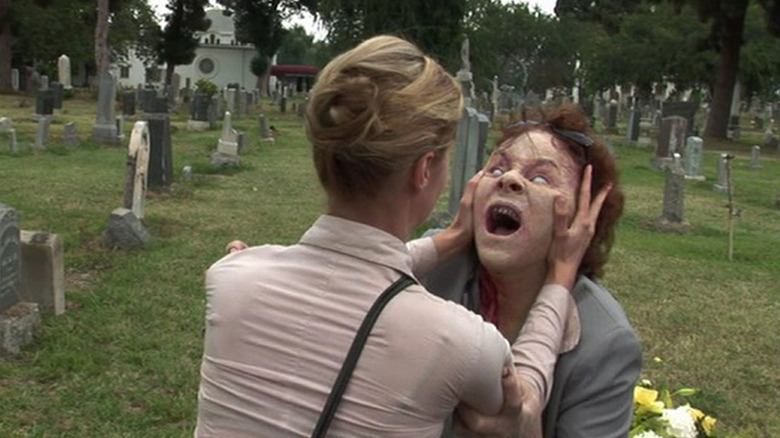
A remake of George Romero's 1968 horror classic, "Night of the Living Dead 3D" is the one we wish hadn't been made. It's a bland rehash of the original, made with absolutely no input from Romero or anyone else who was involved with "Night of the Living Dead."
The result? An absolutely shocking adaptation of a real classic. It's very clearly a cynical cash-in, and even an appearance from Sid Haig can't save "Night of the Living Dead 3D" from itself. The film is devoid of any artistic merit of its own, relying solely on its association with the original film to dupe the audience into thinking this might be an decent horror flick. Spoiler: it isn't.
As for the 3D aspect, it adds very little, but that's not really surprising. Based on old-school stereoscopic tech that required the red and blue anaglyph 3D glasses, its retro styling might seem cute at first, but even as a gimmick the 3D adds nothing to this lifeless retread. "Night of the Living Dead 3D" opens with a shot of the original movie playing on TV ... and that's about as good as it gets.
There are several moments that were clearly designed to capitalize on the 3D effect, with POV shots giving us a zombie's-eye-view of getting nailed by survivors in a variety of different ways. But the anaglyph 3D really loses its charm when you consider the film was made in 2006. Even 3D films of the '50s managed to use the tech in more innovative ways.
Parasite (1982)
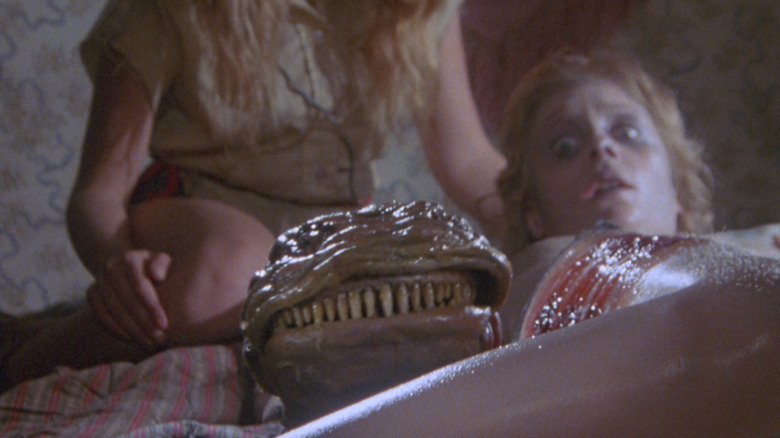
No, no that "Parasite." This one is the 1982 sci-fi horror flick starring Demi Moore in her first major film role. "Parasite" tells the story of Dr. Paul Dean (Robert Glaudini), a scientist who has created a new life form for an organization known as the Merchants, who are basically in charge of a post-apocalyptic America. Escaping the group and fleeing across the country, Dr. Dean is looking for a way to destroy the parasite. That's when he's helped by a young lemon grower (???) played by Demi Moore.
It's a slow, plodding slog in between camp scenes of utter movie carnage. Even Moore herself identified "Parasite 3D" as the worst movie she's ever been in. There's really not much more to be said. It absolutely is the worst Demi Moore film, with plenty of cheesy lines, terrible acting, and some incredibly low-fi effects. The 3D scenes are infrequent and, at best, a mild distraction from the rest of the film's flaws.
Even then, they're not really up to scratch. One of the better 3D moments sees the parasite bursting from the body of one of its victims. But "Alien" it ain't. The worst offender is undoubtedly a long, slow zoom-in to a body impaled on a pipe, with the pipe leaning out towards the audience in gloriously gory 3D.
Read this next: The Horror Movies We Can't Wait To See In 2022
The post 3D Moments That Made These Horror Movies More Hilarious Than Terrifying appeared first on /Film.
Why You Might Want to Shower Before Your Run

When it comes to running in the heat, I’m a wimp. (When it comes to a lot of things, I am a wimp.) After running a spring marathon, I’ve struggled to resume training and get myself out the door and into the summer weather. Then I remembered one of my hacks that I usually reserve for pre-race nerves: A quick shower.
Sigourney Weaver Is Playing Jake And Neytiri's Teen Daughter In Avatar: The Way Of Water
Once "Avatar: The Way of Water" finally makes its long-delayed debut, the blockbuster sequel will likely provide answers to all of our most burning questions. Will modern audiences feel as eager as they did back in 2009 to visit the world of Pandora and its blue-skinned inhabitants? Can director James Cameron prove the doubters wrong once again and lead an ambitious project to box office glory? Are we about to get even more disturbing details about Na'vi procreation techniques?
For the sickos among us (no judgment, folks!), the answer to that last question appears to be a resounding -- and slightly confusing -- yes. Who am I kidding, you all saw the above headline and so there's no point beating around the bush here. Thanks to Empire's latest feature on the upcoming "Avatar" sequel, we've been introduced to a brand-new character in the film who'll be played by a very familiar face. Remember, I'm just the messenger here who is equally as befuddled as you are that actor Sigourney Weaver (whose character Dr. Grace Augustine, you may remember, died during the climax of the original movie) is returning -- not as a resurrected Augustine, as we all naturally assumed, but as a completely different character altogether.
Apparently, Weaver will play a character named Kiri. Yes, you'll be interested to know that she's a Na'vi. Weirdly enough, however, she's going to be the adopted daughter of returning characters Jake Sully (Sam Worthington) and Neytiri (Zoe Saldaña).
'I Was Thrilled To Be Given That Challenge'
To its credit, James Cameron was never afraid to take big and bold swings with 2009's "Avatar" and it looks as if his follow-up will go even further. Sigourney Weaver, herself no stranger to Cameron's storytelling sensibilities, had this to say about suiting up as possibly the most unexpected character she's ever portrayed.
"I think we all pretty much remember what we were feeling as adolescents. I certainly do. I was 5'10 or 5'11 when I was 11. I felt strongly that Kiri would feel awkward a lot of the time. She's searching for who she is. I was thrilled to be given that challenge by Jim."
Considering the record-breaking run of the original film and the comparatively tamer blockbusters that have followed in its wake, it should actually be considered a breath of fresh air that Cameron is seemingly intent on taking risks -- even the risk of looking a little silly to the skeptics among us -- with "The Way of Water." Judging by the overall reactions every time I've seen the trailer in theaters, I get the feeling general audiences are ready to go along with the ride. Cameron hopes so as well and described how he thought Weaver handled this particular challenge:
"As an acting challenge, it's big. We're gonna have a 60-something actor playing a character [decades younger than] her actual biological age. Sig thought it was all kinds of fun."
"Sigourney just became younger. She looked younger, she had more energy, and she never quite stepped out of Kiri for our whole capture period. She had a glow on her face and lightness in her step and a fun spirit."
Barring any more delays, "Avatar: The Way of Water" will hit theaters on December 16, 2022.
Read this next: 14 Sequels That Truly Didn't Need To Happen
The post Sigourney Weaver is Playing Jake And Neytiri's Teen Daughter in Avatar: The Way of Water appeared first on /Film.
Teardown Reveals Apple’s Latest 13-Inch MacBook Pro is Basically Last Generation’s Model With an M2 Chip

Apple announced the new M2 MacBook Pro earlier in June with the same design as the M1 variant. While there are no new design variations, the M2 chip brings the required performance upgrades to the table. However, the base model is still slower than the M1 MacBook Pro due to the single NAND flash storage chip. According to the new M2 MacBook Pro teardown by iFixit, Apple has simply recycled the old hardware and added a new chip. Scroll down to read more details on the subject.
Teardown of The New M2 MacBook Pro Shows Similar Internals and Component Layout As M1 MacBook Pro
iFixit's latest teardown reveals the insides of the new M2 MacBook Pro which can be compared to the last generation's M1 MacBook Pro. To sum it all up, Apple has not changed anything on the inside except the processor. Apple reused the body of the M1 MacBook Air since both models are identical in terms of design. Furthermore, iFixit noted that even the bottom cover of the new M2 MacBook Pro is the same as the version introduced in 2020. Both models share the model number "A2338" engraved on the bottom along with the same FCC ID. This means that Apple simply recycled the old hardware with a new chip on board.
It was revealed in MKBHD's unboxing of the M2 MacBook Pro that even the box is the same as its predecessor. The Cupertino giant simply updated the box with a sticker with the listing of technical specifications over the old markings. As for the M2 MacBook Pro teardown, almost all internal components, connectors and screws are the same as last generation's model with an M1 chip. While some chips are changed, they are located in the same position as the M1 MacBook Pro.

The teardown also reveals that the heatsink on the M2 MacBook Pro features squared corners but it does not have an impact on the functionality. While removing the Logic board is easy, there are chances that internal components can be easily damaged if the right tools are not used. iFixit also tried to replace the Logic board of the M2 MacBook Pro but it renders the device useless since the keyboard and trackpad do not respond. A YouTuber also tried his luck to upgrade the M1 MacBook Pro with an M2 chip but the experiment failed.
It was also pointed out in the video that the single NAND flash storage chip in the M2 MacBook Pro slows down the data transfer speed compared to its predecessor which has dual NAND chips. In terms of repairability, Apple has made it difficult for users to repair the machine themselves. Apple will potentially add the M2 MacBook Pro to its Self Repair Program for easier repairability. You can check out the teardown video below for more details.
While the new MacBook Pro features a brand new chip from Apple, we are still waiting for the M2 MacBook Air. The new MacBook Air was revealed at the company's WWDC 2022 event in June with a brand-new design and the new M2 processor for enhanced performance and battery life. It remains to be seen how the M2 MacBook Air will stack up against the M2 MacBook Pro.
We will keep you guys updated on the latest, so be sure to stick around for more details. This is all there is to it, folks. Share your valuable insights regarding the M2 MacBook Pro teardown in the comments section below.
The post Teardown Reveals Apple’s Latest 13-Inch MacBook Pro is Basically Last Generation’s Model With an M2 Chip by Ali Salman appeared first on Wccftech.
The Geekbox: Episode 626
Wherein we discuss Teenage Mutant Ninja Turtles: Shredder's Revenge, RRR, Hard Boiled, Final Fantasy XIV, Succession, Kevin Smith, music gatekeeping, Westworld, and Ms. Marvel. Starring Ryan Scott, Justin Haywald, and Ryan Higgins.
Stranger Things Season 4 Volume 2 Ending Explained: Welcome To The New Hawkins
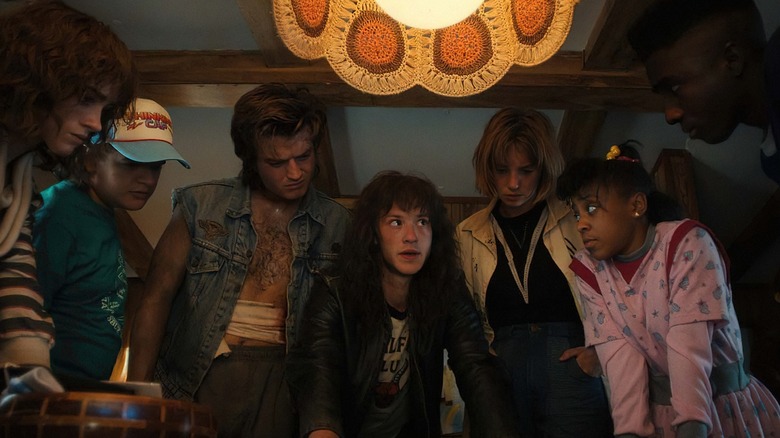
This post contains major spoilers for the final two episodes of "Stranger Things" season 4.
The end of "Stranger Things 4" is here, and Hawkins will never be the same. Sure, that's the type of line that's been bandied about pretty much every season since the show began, but this time, it genuinely feels true. The massive two-part finale of the new season just dropped, and with a runtime of nearly four hours, it's a game-changer on every level.
When we last saw the Hawkins crew in volume 1, they were still scattered to the four corners of the world, with Dusin (Gaten Matarazzo), Lucas (Caleb McLaughlin), Max (Sadie Sink), and the older teens facing down Vecna in the Upside Down in Hawkins while most their friends were on a road trip towards the midwest. Meanwhile, Joyce (Winona Ryder) and Murray (Brett Gelman) just saved Hopper (David Harbour) in Russia, while El (Millie Bobby Brown) is still stuck in an underground laboratory, figuring out Vecna's secrets.
The season's penultimate episode covers a lot of ground, and is basically action-packed enough to seem like a finale all on its own. An inordinate amount of the episode is spent on Dr. Brenner (Matthew Modine), the creepy, paternalistic mad scientist who came back from the dead this season to rehash old times with Eleven. But by episode's end, he's dead for real, shot down by military snipers after trying to carry a sedated, newly re-superpowered El out of the bunker. His reintroduction, and the show's forceful attempts to frame his as anything other than a controlling villain, were among the weaker parts of the season. So it's super satisfying to see El walk finally away from him, refusing to entertain his dying wish that she simply understand that every heinous thing he's done was for her. Yeah right, man. Rest in pieces.
Episode 8 Reveals Vecna's Game Plan
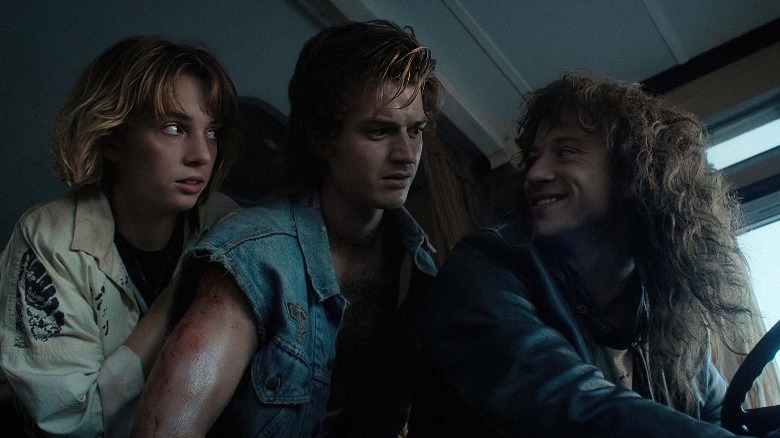
The eighth episode features several major character moments, like Steve (Joe Keery) telling Nancy (Natalia Dyer) about his dream of starting a family (what an awkward topic to broach with your ex), and Will (Noah Schnapp) basically confessing his love to a poker-faced Mike (Finn Wolfhard) via a coded conversation about El. Still, in terms of the season's endgame, its the chapter's additions to overarching "Stranger Things" lore that may be their most important part.
Some of the mythology downloads in episode eight seem like vague stand-ins for clearer information we might get in season 5, like when Hopper and Joyce see Demogorgons preserved in liquid stasis and a hazy black dust cloud that's somehow part of the Upside Down hive mind. El also accuses Brenner of training her so he could use her mind to search for Vecna, aka Henry AKA 001 (Jamie Campbell Bower), as opposed to the Russians, but he denies it, so we may never really know what's true there. What we do know, though, is that Vecna is aiming to rip open the fabric between the real world and the Upside Down and spill otherworldly darkness into Hawkins.
Nancy sees this in a Vecna-prompted vision that she relays back in a state of shock, saying she saw Hawkins shrouded in flames and black clouds, an army of monsters, and her whole family dead. It's pretty apocalyptic stuff, and Dyer does some series-best work here playing Nancy as thoroughly shaken up by the whole thing. It gets even more dire when the group realizes that Vecna is working in fours -- four clock chimes, four gates, four kills -- and just needs one more sacrifice to make it happen. Max volunteers to lure him in, and the episode ends with the Hawkins kids somberly heading into the Creel house, armed to the teeth and ready to go down fighting.
A Four-Phase Plan
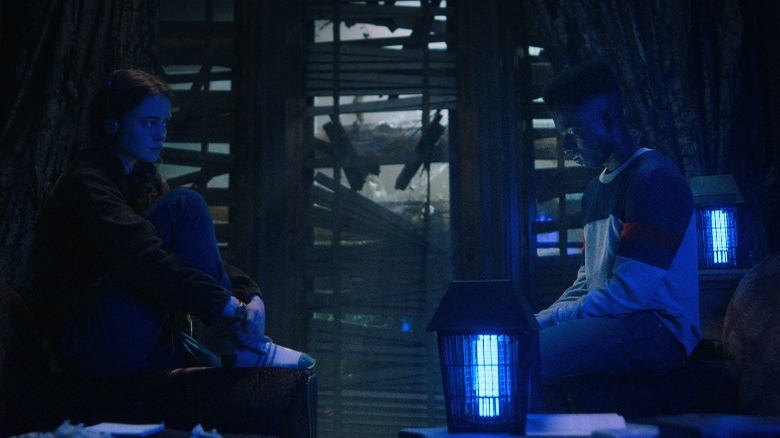
The "Stranger Things" finale is a behemoth of an episode, clocking in at 2 hours and 30 minutes. Nearly 2 hours of that time is devoted to the climactic cross-continental fight with Vecna, while an extended epilogue wraps up loose ends and pulls off a twist that sends the show catapulting towards its fifth season endgame. In Hawkins, the gang has a four-part plan to burn the bad guy's lair to the ground, and it all goes pretty well for a while.
At the Creel house, Erica (Priah Ferguson) signals that the coast is clear of jocks and angry mobs, at which point Max lures Vecna in by turning off her ever-present Kate Bush soundtrack and getting into a dark headspace that will make her seem vulnerable. Lucas watches over her as she goes into a trance, pulled back into the Upside Down by Vecna. Meanwhile, Dustin and Eddie (Joseph Quinn) are meant to be chasing off the demo-bats in the Upside Down so that Robin (Maya Hawke) and Steve can torch the place once they spot Vecna.
This all goes pretty well, until it doesn't. In a poignant moment, Max confesses that she prayed for her bullying brother Billy to die, then when he really did, she thought it was her fault. Lucas, who Max had just reconciled with earlier that night, appears to get freaked out by this, only it soon becomes clear that this mean version of him is actually a Vecna-induced hallucination. Meanwhile, the basketball team's head a-hole Jason (Mason Dye) has tracked the group to the house, and when he sees Max in a trance, he thinks Lucas must be part of the cult he made up because he's the worst. The two duke it out in a bloody fight, with Lucas telling Jason he never should have tried to fit in with jerks like him in the first place.
Meanwhile, Outside Hawkins
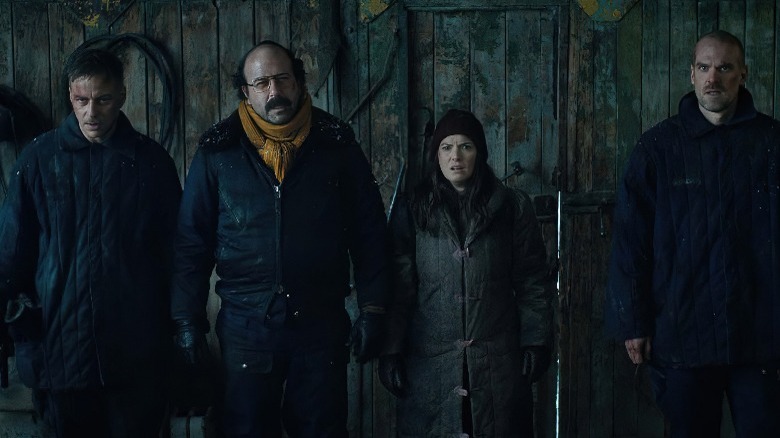
Although Joyce, Hopper, and Murray are still trapped in Russia with a helicopter that won't start, they catch wind of what's happening in Hawkins and figure they can help by taking out some demo-beasties. That means breaking back into the prison they just left, a plan that turns out to be pretty easy since the demogorgons are eating pretty much everyone else there by the time they arrive. Luckily, Hopper and Joyce get a rushed, cute moment of intimacy (Jopper hive rise!) before their lives are on the line again. Also, they've got flamethrowers this time.
That same night, somewhere on a highway in America, El has reunited with the Pizza van gang just in time to realize she won't make it to Hawkins in time to save everyone. Instead, the group decides to stop at a Surfer Boy Pizza, which Argyle (Eduardo Franco) hilariously commandeers via some secret pizza boy pact and an offering of some of that good kush. The group fills the pizza freezer with ice water and salt to make El a sensory deprivation tank, so she can help Max from afar by going to that inky black astral projection space. There's also a funny bit where El and Argyle force Mike to try pineapple pizza, and Jonathan (Charlie Heaton) has a heart-to-heart with Will that, like all other conversations about Will's sexuality this season, involves one person talking around a subject with coded language and the other one not saying much at all. Still, it's a sweet brotherly moment and a much-needed gesture of love for Will.
The Heroes Are Losing
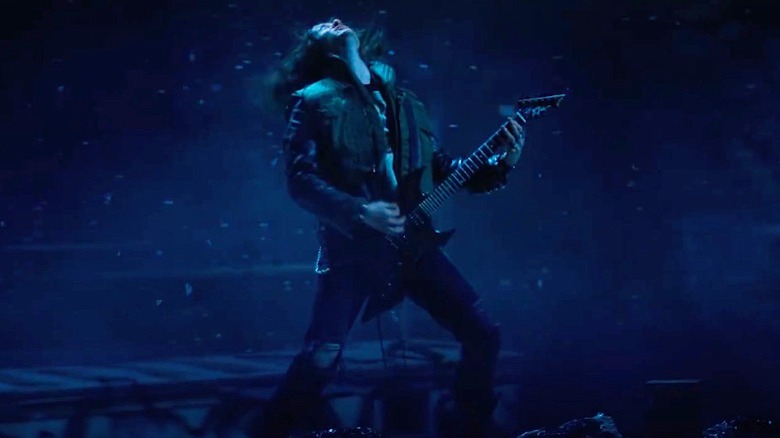
By this point, this one-two punch of "Stranger Things" episodes has given almost everyone a big calm-before-the-storm moment that, for fans who are used to this TV show ripping their heartstrings out, makes it seem like any of them could die at any moment. Hopper and Joyce finally make out, Lucas and Max plan a movie date, Steve tells Nancy he pictures a future with her, and Eddie seems to have fully dropped his edgelord persona and is now besties with Dustin. Unfortunately, it's that last group that the clock finally runs out on. Eddie and Dusin's plan has an epic start: the metalhead shreds his electric guitar, playing "Master of Puppets" by Metallica to draw the swarm of demo-bats away from where Nancy and Robin are headed. Only, the bat swarm starts to leave the pair alone after cornering them in the Upside Down version of the trailer.
This is the point where everyone starts to lose. It's a surprising turn of events given that "Stranger Things" has always adhered to the formula of '80s adventure movies that typically see the teen heroes triumph. Not this time. It's impossible to worry about just one person here, because everyone is suddenly in peril all at once. After Dustin hops back into the real world, Eddie decides to draw the bats away for good -- to not run away, for once in his life -- and is overwhelmed by a huge torrent of the flying, biting creatures. Max has been pulled into a warped version of her memories of the Snow Ball, while in the real world, Vecna levitates her and begins to snap her limbs. Hopper gets overcome by a demo-dog. Nancy, Steve, and Robin get choked out by those ever-present Upside Down tendrils.
The Power Of Love, Aww
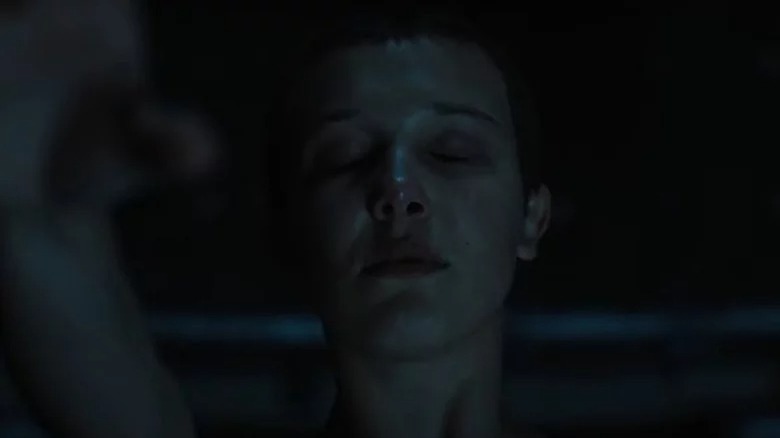
El reaches Max and Vecna -- who starts doing another villainous monologue about his vision for the world, that's honestly pretty redundant after episode seven -- but she can't stop him from hurting Max. We see her body twitching in the pizza parlor freezer as she tries to stop the villain, but it's just not working. Then, the hail mary, which is either one of the sweetest things "Stranger Things" has ever done or one of the most ridiculous. Will gives Mike a pep talk, telling him he's the heart of the group. Mike, who's had a bad case of "I love you" constipation for several seasons now, starts telling Eleven every nice thing he can think of the say about her. He says she's a superhero with or without powers, and he's loved her since the day he met her. He's being her version of Kate Bush, basically, tethering her to reality when Vecna's realm threatens to swallow her.
It works! El KO's Vecna and his hordes of helpers -- including the demo-dogs, demo-bats, and those vines -- all fall away. This is an overwhelming, fast-moving scene, but it appears that El critically injures the villain in a way that makes him disconnect from the Upside Down hivemind. In the Upside Down (which is different than Vecna's lair, so there's two of him, apparently), the older teens hit the version of Vecna with all the plugged-in spidery tendrils with a molotov cocktail, effectively finishing him off, too. Only, he doesn't seem that dead: before El's face-off with the creature ends, he tells her, "This is only the beginning, the beginning of the end. You have already lost."
Heartbreak And Ruin
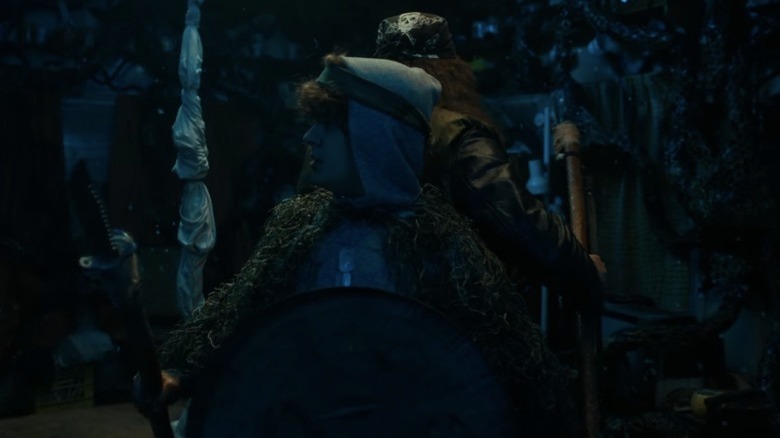
It turns out, he's right. When the dust settles, the real-life Hawkins is in ruins, ravaged by a 7.4 earthquake that split the ground apart. Jason, laying on the fault line after his fight with Lucas, basically disintigrates, and he's not the only casualty we know. By the time Dustin catches up to Eddie in the Upside Down, the rocker is bleeding from the mouth, having been bitten in ribbons by the demo-bats. "I didnt run away this time, right?" Eddie says. Dustin is there for him as he dies, a hero, even if no one else knows it.
Max isn't faring much better. Vecna made her his final sacrifice, crumpling her up in much the same way he did with his past victims, and Lucas holds her as she admits in a panic that she can't feel or see. She seems to die -- doctors later say her heart stopped for over a minute -- but El, still astral projecting, simply isn't having it. She's been by Max's side this whole time, and is sobbing now, but she pulls herself together. Calmly and kindly, she whispers, "No, you're not going." Somehow, as a blur of their memories rushes by, she makes Max's heart beat again.
This whole season of "Stranger Things" has had a surprisingly religious through-line, from the townsfolks' Christian zealotry to Vecna's ritualized apocalypse to Max's references to prayer, and in this moment, El seems almost angelic. The show has always grounded its fantasy elements in bits of sci-fi, too, and that could be the case here. El almost seems angelic or diety-like in her ability to resurrect her friend, but her powers have also obviously expanded since she regained them. It's almost as if whatever dark hold Vecna holds over people, El has the opposite.
The New Upside Down
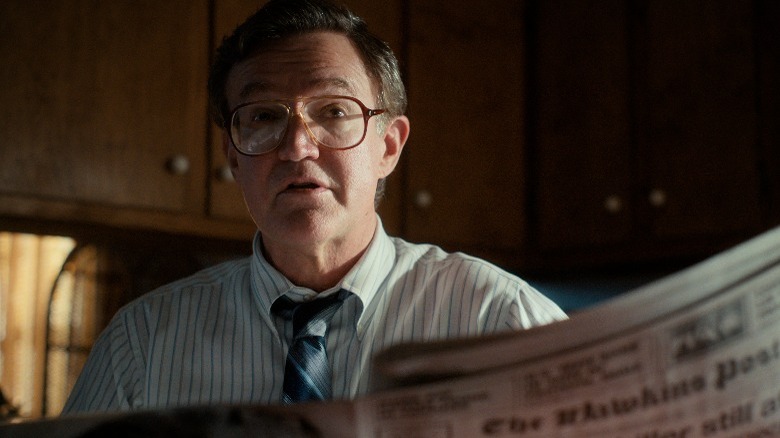
Either way, when the action picks up two days after the fight, Max is alive but in a coma. Poor Lucas has already read all of "The Talisman" out loud to her. Some of the teens are helping out at the community center, where Dustin (noticably limping) tells Eddie's uncle he was a hero. The news is calling Hawkins a gate to hell, opened by Eddie and the Hellfire cult, but Mr. Wheeler doesn't trust all that BS. The pizza van gang makes it home, as do those the squad from Russia. Hopper and El reunite, and if we hadn't already been crying for the last 40 minutes, we would be now. They're not exactly happy, but they're all together. Except, Will says he knows Vecna is still out there in some form or another. Then he gets a sudden chill, the same kind that indicated the Upside Down's presence in season 2.
The season ends on an ominous, massive cliffhanger. Within moments of Hopper's return, ash begins to fall. At the hospital, and the community center, and Hopper's cabin, and Mike's house, gray particles drift insidiously through the air while all our favorite characters look on. A group including the Byers family, the Wheeler siblings, and Hopper heads out to an open field. It looks like the one where the kids played in season 3, which may as well have been 100 years ago now. There's a line straight through the blooming flowers: on one side, life. On the other, everything is dead and gray. On the horizon, red lightning cracks and black smoke chokes the sky. It's Nancy's vision, and Vecna's dark dream realized: the Upside Down and the real world are now one and the same.
Read this next: Sci-Fi Box Office Bombs That Deserve A Second Chance
The post Stranger Things Season 4 Volume 2 Ending Explained: Welcome To The New Hawkins appeared first on /Film.
Google: Half of 2022's Zero-Days Are Variants of Previous Vulnerabilities
Google Project Zero has observed a total of 18 exploited zero-day vulnerabilities in the first half of 2022, at least half of which exist because previous bugs were not properly addressed.
How to survive the inevitable CD revival
In 1982, when the BBC’s prime-time technology show – Tomorrow’s World – did a segment on a new musical format called the “Compact Disc” the presenter skeptically asked "Whether there's a market for this, remains to be seen". We all know what happened next, but even in the early ‘80s the benefits of CDs should have been clear: high quality, non-degrading sound in a compact format. Oh, and you could even skip, shuffle and repeat tracks, which, in a pre-digital world, truly felt like the future
The Compact Disc turns 40 this year, and there are already signals the format is primed for a mini revival. For the first time in 17 years, CD sales actually went up - and by almost 50 percent, according to the RIAA’s sales database.
It’s still a long way from the format’s peak. In 2021, 46.6 million CDs were shipped in the US – compared to nearly a billion back in 2000. For context, that 46.6 million barely accounts for four percent of last year’s total music revenue. Vinyl albums, by contrast, sold fewer overall units (39.7M) but are more of a money spinner for artists (seven percent of total revenues).
Some reports claim that the uptick in CD sales is mostly due to mega-artists like Adele and BTS releasing new albums (the former’s 30 accounted for two percent of total CD sales alone). But there are other potential – and more practical – contributing factors, too, including the pandemic.
“CD sales are growing again now that retail stores are reopening and artists are back on tour. And while CDs haven’t yet seen the same type of revival as vinyl, the CD format remains a steady revenue stream for independent artists.” Rob Bach, COO of CD Baby told Engadget. They should know, as one of their services is the production and distribution of CDs for indie bands.
Kevin Breuner, SVP of Artist Engagement and Education for the company, thinks there’s an increasing appetite for CDs as memorabilia, rather than just as a way of playing music. “Part of it is that streaming hasn’t replaced anything at the merch table … the appeal of a physical item like a CD is that it’s a piece of memorabilia in a live setting, something you can have signed by artists. Similarly, for artists, there’s nothing that can replace when a fan goes back to the merch table to buy a CD or a t-shirt; it’s always been that way.”
There’s also the fact that what once seemed restrictive to younger listeners – having to own a song if you wanted to hear it – now presents a different way of enjoying music. A good album isn’t merely a collection of songs, but a structured experience to be enjoyed from start to finish. You can, of course, do this with streaming, but a CD requires getting up to change, Spotify is usually just a click away.
The CD format is experiencing a nice comeback, I'm sure they'll sound pretty sweet played via the new @MarantzOfficial CD 60 player #audiophile#avtweepshttps://t.co/qnSDtm3RfZ
— Arlen Schweiger (@ArlenSchweiger) May 23, 2022
CDs launched in Japan in October 1982. The format and hardware to play it on didn’t land in the US and Europe until the following year. Adoption was relatively swift and just two years later the first million-selling CD album - Brothers in Arms by Dire Straits – would cement the shiny disc's popularity. By the early ‘90s, assisted by increasingly smaller, affordable and even portable players, the CD was the de facto way to listen to music. And for good reason.
In this new digital world, the CD format was consistent in a way that analog never could be. What became known as the “Red Book” standard – two-channel 16-bit PCM at 44.1kHz – would be the prevailing specification from there on out. When someone used to say “it’s CD quality” one might assume that’s what they were referring to.
This standard is considered the minimum requirement to be called “lossless” by today's streaming services. Of course, how or what you record at 16-bit/44.1 is really what matters, but that’s a whole other story.
More important than any of this, for the labels and artists at least, is that the arrival of the CD meant they could re-sell us our entire music collection in the new wonder format. The ‘90s were a good time to be in the music industry, at least until Sean and Shawn came along.
There were other benefits to this new digital medium, too. And not just the aforementioned ability to skip/program/shuffle tracks. With CDs, you could hide bonus tracks in new ways that would otherwise be visible on a vinyl record or instantly found by anyone that left a cassette tape running.
Even more exciting? Once PCs started being a more common feature in homes, artists and labels realized you could bundle in entirely different bonus media like videos and karaoke versions – as found on some versions of Americana by The Offspring, for example.
Before we show you some ways you can enjoy/rediscover the joys of compact discs, bear in mind the experience was far from flawless.
Despite being more durable than vinyl, it definitely is possible to scratch a CD. When a record has a scratch, it’s almost charming. With CDs, it’s more like walking slowly through hell as they dig up the streets. If your disc was damaged, it also might work in some players yet, frustratingly, not in others. Many an hour has been wasted cleaning and reseating a CD in the hope it would take.
Are CD’s the aesthetic now? 👀 https://t.co/9Ir6OFMjG5
— Mother of the House of Shaming (@mmkayrulz) May 26, 2022
Of course, many CD players took only one disc, so you’d frequently be swapping them out. If you knew someone who had every CD in the right jewel case, that was often a tell that this person doesn’t listen to their music enthusiastically or often enough (It’s possible they were just slightly organized, but where’s the fun in that). This “which disc is in which case” problem became even worse when someone decided CD singles – one song you wanted and some less good songs on one disc – were a good idea.
Not to mention the fragility of the cases they came in. Jewel case hinges would crack just by looking at them, while center hubs (the part that held the disc in place) would crumble no matter how well you handled things. Most often while moving house or the aforementioned enthusiastic listening with friends.
Unlike other formats, the CD is unique in that it played a part in its own demise. With the advent of CD burners, you could easily copy your friends’ album collection, print out album artwork and even print circular stickers with the CD art on them, too. This was how music was stolen for the short period when CD burners and blank discs were affordable and online piracy hadn’t taken hold. The CD was then effectively relegated to the role of external storage medium before quietly regressing into obscurity. Until now, of course.
With those small challenges in mind, if you’re ready and willing to give the humble Compact Disc another, uhm, spin, here are some recommendations, new and old, cheap and not-so, to dive into the world of the CD.
Where to find CDs
Maybe you already have a collection, if so, you’re good to go. But if you’re new around here, you’re going to want to grab a few albums to get you started. For current, mainstream music you’ll be able to find a selection at Target and Walmart. Jeff Bezos will of course also happily sell you a CD. Tower Records also recently returned as an online-only store which also has a good selection of CDs. For more of an indie-artist focus, there’s of course Bandcamp – or the good old-fashioned merch stall at a gig.
You can, of course, also navigate the secondhand market either locally (thrift stores, local record shops) or online at places like Discogs, eBay or even apps like Letgo.
What you may already own
Maybe, you have a CD player unironically in your front room right now. We admire the dedication. Or perhaps you have an old one in storage somewhere? But if you’re young enough to have gone straight to streaming, it’s worth asking family and friends in case they have one gathering dust somewhere.
That said, you might even own a CD player without even knowing it. If you have an Xbox with a disc drive, congratulations, you’re already in the club. PlayStation fans, however, need either a PS1 (original), a PS2 or a PS3, as after that Sony decided the functionality for audio discs was no longer needed.
Cheap and easy
There was a brief period where the only CD player in the house might well have been in your PC. Primarily used for installing software or the drivers for a peripheral (yeah, we know, bad times) the CD-ROM drive was also good for playing music too.
Most PC cases these days aren’t really made with a CD-R drive in mind, and the last Mac to include a CD drive was the 2012 MacBook Pro. That model was discontinued in 2016, the same year Apple nixed the iPhone’s headphone jack - a rough year for many music listeners.
No worries, there’s a sort of dongle for that. You can pick up a USB CD-Drive for a little over the price of one album, such as this one for a reasonable $22. You’ll also get DVD and CD burning functionality thrown in, which surely will also be due their own revivals before long.
A new take on a classic
For many, the advent of the portable CD player was a long time coming. But the format wasn’t entirely suited to being in motion. Not initially at least, with even the slightest of movements causing a disc to skip. Over time this was resolved as players were able to buffer more music to ride out those bumps.
NINM Labs’ “Long Time No See” portable CD player (approx $117) blends the best of the past with modern conveniences like Bluetooth and USB power. The transparent design gives off early-aughts Game Boy vibes, while a clever speaker “lid” accessory means you’re never without a way to listen to those discs. That said, there’s of course the aforementioned Bluetooth for connecting to speakers and headphones and even a good old fashioned headphone port.
What’s more, you can run the player directly from USB power or AA batteries. You can even charge said batteries while it’s connected over USB. And the whole thing is magnetic, too, so you can get creative with where you place it.
Taking things to a (much) higher level
For the most authentic experience, it has to be HiFi separates. In the ‘90s a good HiFi was the quickest way to let someone know you were serious about music. No MegaBASS or often even an EQ for these dedicated listeners, just pure unadulterated sound. They may also be seen with magic pebbles or some CDs in the freezer.
Cambridge Audio has been around long enough to know what makes a great CD player. Its CXC “player” comes right in at $700. The CXC doesn’t even convert the CD to audio, it passes the digital signal directly to… something else, as long as it has either S/PDIF coaxial or TOSLINK in puts. You may as well complete the look with Cambridge Audio’s CXA61 amplifier ($1,100) with a DAC. It’s the perfect companion for the CXC both in terms of looks and connectivity. Of course, spending $1,800 on fancy HiFi gear doesn’t always mean you’re set. You still need some speakers, so you might as well toss in the SX60 bookshelf set for the fully-loaded CD setup.
Our lord and saviour once said, "Blessed are the cheese makers". But expect legal action if you name a cheese sandwich after him [Facepalm]
Microsoft Cloud Computing System Suffering From Global Shortage
Read more of this story at Slashdot.





